|
(11) | EP 0 422 886 B1 |
| (12) | EUROPEAN PATENT SPECIFICATION |
|
|
| (54) |
Production of aromatic polyimide membranes Herstellung von Membranen auf der Basis von aromatischen Polyimiden Fabrication de membranes à base de polyimide aromatique |
|
|
|||||||||||||||||||||||||||||||
|
||||||||||||||||||||||||||||||||
| Note: Within nine months from the publication of the mention of the grant of the European patent, any person may give notice to the European Patent Office of opposition to the European patent granted. Notice of opposition shall be filed in a written reasoned statement. It shall not be deemed to have been filed until the opposition fee has been paid. (Art. 99(1) European Patent Convention). |
[0001] This invention relates to an improved aromatic polyimide separating membrane and a process for making it. More particularly, it relates to a process of producing such membranes from a dope solution comprising polymeric base material and an oligomeric or polymeric aromatic epoxy resin in a solvent wherein the epoxy resin is soluble in the solvent, the polymer base material and the final membrane.
[0002] It is well known that an aromatic polyimide dense film or asymmetric membrane has utility in separating gases. Such polyimide membranes have an imide linkage in the polymer backbone. They are taught in US-Re-30,351, which is incorporated herein by reference. US-A-4,705,540; US-A-4,717,394 and co-pending application EP-A-422 885 filed 9.10.90, published 17.4.91 (AD5746)*, which are incorporated herein by reference, disclose preferred polyimide membranes.
* - filed contemporaneously herewith.
[0003] The polyimide membranes can be produced by casting films or extruding hollow fibers from dope solution of aromatic polyimide or corresponding polyamic acid precursors in a solvent mixture and evaporating the solvent (or, in the case of the asymmetric membrane, evaporating a portion of the solvent from one side of the film or the hollow fiber and quenching with a nonsolvent). Such processes are taught in the above references as well as US-A-4,370,290; 4,474,662; 4,485,056; and 4,528,004, which are incorporated by reference. In the case of the polyamic acid, cyclizing by a suitable treatment such as the application of heat is needed.
[0004] The preferred asymmetric membrane is characterized by a thin skin of polymer supported by a generally cellular structure. The thin skin is preferred since it allows high flux or permeation of gases. Forming a highly permeable membrane also leads to formation of submicroscopic holes which pass gases indiscriminately causing the membrane to have an effective separation value for most pairs of gases which is less than the intrinsic separation value of the polymer from which the membrane is made. Posttreating is typically used to heal the holes.
[0005] US-A-4,370,290 discloses an aromatic polyimide porous fiber produced from a spin dope solution of a polymer material consisting of at least one polyimide in a solvent comprising, as a main component, at least one phenolic compound.
[0006] US-A-4,474,662 discloses an aromatic polyimide porous membrane produced by drying a thin layer of dope solution containing an aromatic polyamic acid in a mixed solvent of polar organic compounds which evaporate at different rates and in which the polyamic acid is soluble to different extents.
[0007] US-A-4,485,056 discloses an aromatic polyimide membrane produced by forming a thin film of a dope solution containing aromatic polyamic acid in a polar organic solvent, coagulating the thin dope solution film in a coagulating liquid containing water and lower aliphatic alcohols, drying the coagulated membrance and heating it to convert it to an aromatic polyimide membrane.
[0008] US-A-4,528,004 discloses an aromatic polyimide porous membrane substrate with at least one surface coated from a dilute solution of aromatic polyimide or polyamic acid dissolved in one or more organic liquids. Prior to applying the dope solution, the porous membrane may be immersed in an treating liquid of at least one member selected from lower aliphatic alcohols, lower aliphatic ketones, benzene-type liquid compounds.
[0009] Co-pending patent application (AD5746) discloses aromatic polyimide membranes compositionally containing phenylindane functions.
[0010] It would be desirable, particularly in the case of asymmetric membranes, if processing improvements could be made and if a membrane with fewer defects could be made prior to posttreatment.
[0011] The present invention relates to the finding that, by adding to the dope (which contains the aromatic polyimide or corresponding polyamic acid precursors in a solvent mixture) certain organic compounds, certain advantages accrue. The resulting unposttreated membrane exhibits a higher selectivity than without the additive and processing, particularly in the case of asymmetric hollow fibers, is made easier.
[0012] The organic additives comprise oligomeric or polymeric residues soluble in the base polyimide or polyamic acid precursor, in the solvent mixture under production conditions and in the final membrane.
[0013] They result from the polymerization of a compound of the following structure:
where Ar represents a divalent aromatic group as hereinafter specified and the resulting repeating units are preferably substituted with halogen atoms at all positions ortho to the glycidyl ether groups.
[0014] The present invention has found utility for membranes composed essentially of polyimide materials, that is, polymers having an imide linkage in their backbone. Such membranes may be dense film, composite or asymmetric with the asymmetric morphology being preferred.
[0015] The preferred material composition of these membranes comprise soluble aromatic polyimide materials, heretofore prepared by typical procedures as taught in the prior art, such as US-Re-30,351. More preferably, the aromatic polyimide compositions incorporate pendant aliphatic side chains. Examples of such compositions are disclosed in, for example, US-A-4,705,540 and US-A-4,717,394. Also, they preferably include aromatic polyimides incorporating phenlyindane groups. Examples of such are disclosed in co-pending application (AD5746).
[0016] The preferred aromatic polyimides for use in the present invention consist essentially of repeating units of the formula
wherein
is selected from the group consisting of
where RI is
or alkylene groups of 1 to 5 carbon atoms, where -RII- is
or alkylene groups of 1 to 5 carbon atoms; Ar is
or mixtures thereof, where -RIIIis
or alkylene groups of 1 to 5 carbon atoms, where -RIV- is
or alkylene groups of 1 to 5 carbon atoms, -X-, -X₁-, -X₂-, and -X₃- independently are alkyl groups of 1 to 5 carbon atoms, alkoxy groups of 1 to 5 carbon atoms, phenyl or phenoxy groups, -Y-, -Y₁-, -Y₂- and -Y₃-independently are -H, -X-, -X₁-, -X₂-, -X₃- or halogen, and where RV, RVI, and RVII are independently -H or lower alkyl having from 1 to 6 carbon atoms; -Ar′- is
or mixtures thereof where -RII-, RV, RVI, and RVII have the above-defined meanings, m and n are fractions from 0 to 1.0 where
, and p is 0 to 3.
[0017] The gas separations membrane is not limited to any specific type or design. The membrane is preferably asymmetric and more preferably in the form of a hollow fiber. The polymeric membrane may be formed as described in the prior art. For example, they may be of the type described in U.S. 4,230,463 or by Cabasso et al in Research and Development of NS-1 and Related Polysulfone Hollow Fibers for Reverse Osmosis Desalination of Seawater (NTIS PB-248666, 7/1975).
[0018] The process of this invention for separating one or more gases from a mixture employs gas separation membranes which may be thin dense film membranes or asymmetric membranes having a thin skin on at least one surface thereof. The asymmetric membrane of this invention preferably has a thin skin with a thickness of less than 10,000 Angstroms on one of its surfaces. More preferably, it has a thin skin with a thickness of less than 2,000 Angstroms on one of its surfaces.
[0019] The process for preparing the above membranes is modified by the process of this invention by adding oligomeric or polymeric residues ("additive") soluble in the base polyimide or polyamic acid precursor, in the solvent mixture under production conditions and in the final membrane. The additive is not fully extracted from the membrane during the process.
[0020] By soluble, it is meant that the additive is soluble in some proportion, that is preferably to at least about 0.5 weight percent. The additive will be considered by one skilled in the art to be soluble if it produces a homogeneous system with the other components in the system.
[0021] Preferably, the additives result from the polymerization of a compound of the following structure:
where Ar represents a divalent aromatic group and the resulting repeating units are preferably substituted with halogen atoms, preferably bromine ions, at all positions ortho to the glycidyl ether groups.
[0022] The divalent aromatic group is of the form
where RVIII is a direct bond or
The molecular weight of the additive should be sufficient to allow solubility as heretofore defined. The weight percent based on the base polyimide polymer will depend on the particular polyimide or polyamic acid precursor, the additive and its molecular weight, the solvent and process conditions. The molecular weight and weight percent together preferably will be sufficient to increase selectivity of oxygen over nitrogen at least 5 %, preferably 10%, from the gas pair oxygen/nitrogen (21/79, mole ratio).
[0023] The most preferred additive, available commercially from M&T Chemicals, Inc. as "Thermoguard", having n repeating units of the form:
where n is sufficiently large to result in a molecular weight of about 700 to 40,000, preferably 700 to 10,000. With the preferred additive, the preferred weight percent based on base polyimide polymer is 5 to 30 wt.% b.o.p.
EXAMPLES
Reference Example 1
[0024] To a stirred solution of 2,4,6-trimethyl-1,3-phenylene diamine (150.24 g, 1.00 mol) in dimethylsulfoxide (2 L) was added 5,5'-[2,2,2-trifluoro-1-(trifluoromethyl)ethylidene]-1,3- - isobenzofurandione (224.22 g. 0.505 mol) and 3,3',4,4'-biphenyltetracarboxlic acid dianhydride (148.58 g, 0.505 mol) under a nitrogen atmosphere at room temperature. The resulting very viscous, orange reaction solution was allowed to stir overnight at room temperature. With rapid stirring, a solution of acetic anhydride (408.4 g, 4.0 mol) and triethylamine (404.8 g, 4.0 mol) was added and the resulting viscous reaction solution allowed to stir at room temperature for 4 hours. The polymer solution was precipitated in water. The resulting white solid was collected by filtration and washed twice with water and methanol. After drying overnight by suction, the polymer was further dried in a vacuum oven (20 inches (51 cm) mercury) (= 68 kPa) at 120°C for 3 hours and at 250°C for 5 hours.
[0025] Films were cast from a 15% solution of the polymer prepared as described above (based on weight) in N-methylpyrrolidone onto a glass plate treated with Du Pont TEFLON® dry lubricant at 100°C with a 15 mil (0,38 mm) knife gap. The films were dried on the plate at 100°C for 30 minutes, cooled to room temperature and dried in a vacuum oven (20 inches (51 cm) mercury) at room temperature overnight. The films were removed from the plate and dried in a vacuum oven (20 inches (51 cm) mercury) at 120°C for 4 hours.
[0026] The film, which was 1.3 mils (33 µm) thick, was tested for mixed gas oxygen/nitrogen (21/79, mole) permeabilities at 505 psig (3581 kPa), 24°C. Results are reported below:
| O₂ Permeability : | 4600 centiBarrer |
| O₂/N₂ Selectivity: | 3.6 |
[0027] A film prepared as described above, which was 1.6 mils thick, was tested for pure gas nitrogen, helium, and carbon dioxide permeabilities at 600 psig, 600 psig, (4236 kPa) and 580 psig (4098 kPa), respectively, at 25°C. Results are reported below:
| He Permeability: | 23,000 centiBarrer |
| CO₂ Permeability: | 65,200 centiBarrer |
| He/N₂ Selectivity: | 19 |
| CO₂/N₂ Selectivity: | 53. |
Reference Example 2
[0028] Films were cast from a solution of 15% wt. of a polymer (prepared similarly to that in Reference Example 1) in N,N-dimethyl acetamide. Films were cast onto a glass plate at 100-110°C with a 15 mil (3.8 x 10⁻⁴m) knife gap. Films were dried on the glass at 100-110°C for at least 20 minutes, the films were then cooled to room temperature. The films while still on the glass plate were dried in a vacuum oven at 100°C for 48 hours. After cooling to room temperature, the films were carefully stripped from the glass plates.
[0029] The films were then tested with mixed gas O₂/N₂(21/79) (mole) at approximately 115 psia (792.8 k Pa) and 35°C. Results are reported below:
| O₂ Productivity: | 4770 centiBarrer |
| O₂/N₂ Selectivity: | 4.07 |
| O₂ Productivity: | 4860 centiBarrer |
| O₂/N₂ Selectivity: | 4.12 |
| O₂ Productivity: | 5090 centiBarrer |
| O₂/N₂ Selectivity: | 4.04 |
| O₂ Productivity: | 5320 centiBarrer |
| O₂/N₂ Selectivity: | 4.13 |
| O₂ Productivity: | 5670 centiBarrer |
| O₂/N₂ Selectivity: | 4.07 |
Example 1
[0030] Films were cast from a solution of 15% wt. solids consisting of a polymer (prepared similarly to that in Reference Example 1) plus 30% wt. b.o.p. (based on polymer) "Thermoguard" 220 (molecular weight M.W. about 700 to 800) in N-methyl pyrrolidone. The solution was cast onto a glass plate treated with Du Pont Teflon® dry lubricant at 100°C with a 15 mil, (3.81x10⁻⁴m) knife gap. The films were dried on plate at 100°C for 30 minutes, and dried overnight in a vacuum oven at room temperature. The films were stripped from the glass plates and further dried in a vacuum oven at 120°C for 4 hours.
[0031] The films were then tested with mixed gas O₂/N₂ (21/79) (mole) at approximately 220 psia (1517 k Pa) and 25°C. Results are reported below:
| O₂ Productivity: | 2781 centiBarrer |
| O₂/N₂ Selectivity: | 5.2 |
Example 2
[0032] Films were cast from a solution of 10% wt. of a polymer (prepared similarly to that in Reference Example 1) in Dichloromethane with 10% wt. b.o.p. "Thermoguard" 230 (M.W. = 4,000). Upon casting, films were covered with a small aluminum pan and allowed to dry overnight. After drying, films were stripped from the glass plates and were placed in a vacuum oven and dried at 200°C for 48 hours. After cooling to room temperature, the films were removed from the vacuum oven.
[0033] The films were then tested with mixed gas O₂/N₂(21/79) (mole) at approximately 500 psia (3447 k Pa) and 35°C. Results are reported below:
| O₂ Productivity: | 3470 centiBarrer |
| O₂/N₂ Selectivity: | 4.3 |
| O₂ Productivity: | 3360 centiBarrer |
| O₂/N₂ Selectivity: | 4.0 |
Example 3
[0034] Films were cast from a solution of 10% wt. of a polymer (prepared similarly to that in Reference Example 1) in Dichloromethane with 20% wt. b.o.p. "Thermoguard" 230 (M.W. = 4,000). Upon casting, films were covered with a small aluminum pan and allowed to dry overnight. After drying, films were stripped from the glass plates and were placed in a vacuum oven and dried at 200°C for 48 hours. After cooling to room temperature, the films were removed from the vacuum oven.
[0035] The films were then tested with mixed gas O₂/N₂ (21/79) (mole) at approximately 100 psia (689.5 k Pa) and 35°C. Results are reported below:
| O₂ Productivity: | 1180 centiBarrer |
| O₂/N₂ Selectivity: | 4.3 |
| O₂ Productivity: | 1050 centiBarrer |
| O₂/N₂ Selectivity: | 4.2 |
Example 4
[0036] Films were cast from a solution of 15% wt. solids consisting of a polymer (prepared similarly to that in Reference Example 1) plus 30% wt. b.o.p. "Thermoguard" 230 (M.W. = 4,000) in N-methyl pyrrolidone. The solution was cast onto a glass plate treated with Du Pont Teflon® dry lubricant at 100°C with a 15 mil (3.81x10⁻⁴ m) knife gap. The films were dried on plate at 100°C for 30 minutes, and dried overnight in a vacuum oven at room temperature. The films were stripped from the glass plates and further dried in a vacuum oven at 120°C for 4 hours.
[0037] The films were then tested with mixed gas O₂/N₂ (21/79) (mole) at approximately 100 psia (689.5 k Pa) and 35°C. Results are reported below:
| O₂ Productivity: | 658 centiBarrer |
| O₂/N₂ Selectivity: | 4.2 |
Example 5
[0038] Films were cast from a solution of 15% wt. solids consisting of a polymer (prepared similarly to that in Reference Example 1) plus 5% wt., 15% wt. and 30% wt. b.o.p. "Thermoguard" 230H (M.W. = 20,000) in N-methyl pyrrolidone. The solution was cast onto a glass plate treated with Du Pont Teflon® dry lubricant at 100°C with a 15 mil (3.81x10⁻⁴ m) knife gap. The films were dried on plate at 100°C for 30 minutes, and dried overnight in a vacuum oven at room temperature. The films were stripped from the glass plates and further dried in a vacuum oven at 120°C for 4 hours.
[0039] The films were then tested with mixed gas O₂/N₂ (21/79) (mole) at approximately 100 psia (689.5 k Pa) and 35°C. Results are reported below:
For 5% wt. "Thermoguard" 230H:
For 15% wt. "Thermoguard" 230H:
For 30% wt. "Thermoguard" 230H:
Example 6
[0043] Films were cast from a solution of 15% wt. solids consisting of a polymer (prepared similarly to that in Reference Example 1) plus 5% wt., 15% wt. and 30% wt. b.o.p. "Thermoguard" 240 (M.W. = 40,000) in N-methyl pyrrolidone. The solution was cast onto a glass plate treated with Du Pont Teflon® dry lubricant at 100°C with a 15 mil (3.81x10⁻⁴ m) knife gap. The films were dried on plate at 100°C for 30 minutes, and dried overnight in a vacuum oven at room temperature. The films were stripped from the glass plates and further dried in a vacuum oven at 120°C for 4 hours.
[0044] The films were then tested with mixed gas O₂/N₂ (21/79) (mole) at approximately 235 psia (1620 k Pa) and 25°C. Results are reported below:
For 5% wt. "Thermoguard" 240:
For 15% wt. "Thermoguard" 240:
For 30% wt. "Thermoguard" 240:
Example 7
[0048] Films were cast from a solution of 15% wt. solids consisting of a polymer (prepared similarly to that in Reference Example 1) plus "Thermoguard" 240 in N-methyl pyrrolidone at a ratio of 1:1. The solution was cast onto a glass plate treated with Du Pont Teflon® dry lubricant at 100°C with a 15 mil (3.81x10⁻⁴ m) knife gap. The films were dried on plate at 100°C for 30 minutes, and dried overnight in a vacuum oven at room temperature. The films were stripped from the glass plates and further dried in a vacuum oven at 120°C for 4 hours.
[0049] The films were then tested with mixed gas O₂/N₂ (21/79) (mole) at approximately 100 psia (689.5 k Pa) and 35°C. Results are reported below:
| O₂ Productivity: | 444 centiBarrer |
| O₂/N₂ Selectivity: | 3.5 |
Reference Example 8
[0050] Films were cast from a solution of 15% wt. solids consisting of "Matrimid 5218" (commercially available from Ciba Geigy) in N-methyl pyrrolidone. The solution was cast onto a glass plate treated with Du Pont Teflon® dry lubricant at 100°C with a 15 mil (3.81x10⁻⁴ m) knife gap. The films were dried on plate at 100°C for 30 minutes, and dried overnight in a vacuum oven at room temperature. The films were stripped from the glass plates and further dried in a vacuum oven at 120°C for 4 hours.
[0051] The films were then tested with mixed gas O₂/N₂ (21/79) (mole) at approximately 500 psia (3447 k Pa) and 25°C. Results are reported below:
| O₂ Productivity: | 134.6 centiBarrer |
| O₂/N₂ Selectivity: | 7.12 |
| O₂ Productivity: | 140.5 centiBarrer |
| O₂/N₂ Selectivity: | 7.11 |
| O₂ Productivity: | 132.4 centiBarrer |
| O₂/N₂ Selectivity: | 7.19 |
Example 9
[0052] Films were cast from a solution of 15% wt. solids consisting of "Matrimid 5218" plus 30% wt. b.o.p. (based on polymer) "Thermoguard" 220 (M.W. = 700 to 800), 230 (M.W. = 4,000), 230H (M.W. = 10,000) and 240 (M.W. = 40,000) in N-methyl pyrrolidone. The solution was cast onto a glass plate treated with Du Pont Teflon® dry lubricant at 100°C with a 15 mil (3.81x10⁻⁴ m) knife gap. The films were dried on plate at 100°C for 30 minutes, and dried overnight in a vacuum oven at room temperature. The films were stripped from the glass plates and further dried in a vacuum oven at 120°C for 4 hours.
[0053] The films were then tested with mixed gas O₂/N₂ (21/79) (mole) at approximately 235 psia (1620 k Pa) and 25°C. Results are reported below:
For 30% wt. "Thermoguard" 220:
For 30% wt. "Thermoguard" 230:
For 30% wt. "Thermoguard" 230H:
For 30% wt. "Thermoguard" 240:
Example 10
[0058] This example describes the preparation and processes therein of asymmetric hollow fiber membranes from "Matrimid 5218" polyimide. The hollow fiber membranes are spun from a hollow fiber spinnerette into a water coagulant as has been taught in the prior art. For example, they may be of the type described in US-A-4,230,463 or of Cabasso et al in Research and Development of NS-1 and Related Polysulfone Hollow Fibers for Reverse Osmosis Desalination of Seawater (NTIS PB-248666, 7/1975).
[0059] A polymer solution was prepared with 27 wt. % solids content of "Matrimid 5218" and 20 wt. % b.o.p. of ""Thermoguard" 230" in N-methyl pyrrolidone.
[0060] The above polymer solution was extruded through a hollow fiber spinnerette with fiber channel dimensions of outer diameter (OD) equal to 21 mils (533 µm) and inner diameter (ID) equal to 10 mils (254 µm) at the rate of 130 cc per hour at 100°C. A solution of 85 volume % N-methylpyrrolidone in water was injected into the fiber base at a rate of 60 cc per hour. The spun fiber passed through an air gap of 10.0 cm at room temperature into a water coagulant bath maintained at 22°C. The fiber was wound up on a drum at the rate of 100 meters per minute.
[0061] The water-wet fiber was dehydrated as taught in US-A-4,080,743; US-A-4,080,744; US-A-4,120,098; and EP-A-219,878. This specifically involved the sequential replacement of water with methanol, the replacement of methanol with "Freon 113" (1,1,2-trichloro-1,2,2-trifluoroethane), and air-drying. The dry fibers were cut into lengths of approximately 20 inches (0.51 m) long and the open ends of the fibers were potted in an epoxy resin within a 1/4-inch (0.00635 m) diameter stainless steel tube to provide loops approximately 9 inches (0.23 m) long. From 10 to 24 fibers were so potted for the individual tests.
[0062] An asymmetric hollow fiber, prepared as described above, was tested for mixed gas oxygen/nitrogen permeabilities at 100 psig (689 kPa), room temperature. Results are reported below:
| O₂ productivity: | 25 GPU |
| O₂/N₂ Selectivity: | 6.2 |
[0063] The outer surfaces of the membrane were contacted with hexane at room temperature for 0.25 hour at a vacuum of 20 inches mercury (67.73 KPa) in the fiber bore. The hexane was drained and the membrane allowed to air-dry.
[0064] The asymmetric membrane treated as above was tested for mixed gas oxygen/nitrogen permeabilities at 100 psig (689 kPa), room temperature. Results are reported below:
| O₂ Productivity: | 10 GPU |
| O₂/N₂ Selectivity: | 6.8 |
Example 11
[0065] Hollow fine fibers of a polymer (prepared similarly to that in Reference Example 1) were spun using the procedure of Example 10 except that the bore fluid composition was 80% by volume dimethylacetamide/dimethylsulfoxide (DMAC/DMSO) in water used at a feed rate of 67. cm³/hr. The polymer spinning solution consisted of 22% of the polymer, 20% wt. b.o.p. "Thermoguard" T-230, 20% wt. b.o.p. tetramethylsulfone (TMS) and 6% wt. b.o.p. acetic anhydride in 1:1 DMAC/DMSO.
[0066] Repeated spinning operations were conducted and gave results as follows:
| Run | Spinneret Temp. | Air Gap | Take-up Speed | k O₂ | O₂/N₂ |
| F | 105°C | 5 cm | 50 M/min | 82 GPU | 4.4 |
| G | 105°C | 2.5 cm | 50 M/min | 113 GPU | 4.5 |
| H | 105°C | 1 cm | 50 M/min | 148 GPU | 4.2 |
Control Example 1
[0067] For control purposes the following comparative procedures were performed under similar conditions to Example 11 using a polymer solution feed rate of 105 cm³/hr and a bore fluid composition of 85% by volume DMAC/DMSO in water used at a feed rate of 60 cm³/hr. The polymer spinning solution consisted of 21% the polymer, 20% wt. b.o.p. lithium nitrate and 20% wt. b.o.p. TMS in 1:1 DMAC/DMSO.
1. An improved process for making gas separation membranes of aromatic polymers having
imide linkages in their backbone from a dope solution of an aromatic polyimide or
a polyamic acid precursor to said aromatic polyimide in a solvent, wherein the improvement
comprises adding sufficient oligomeric or polymeric residue to the dope solution,
wherein the oligomeric or polymeric residue is the polymerisation product of a compound
of the following structure:

where Ar represents a divalent aromatic group of the form

where RVIII is a direct bond or

and said residue being of a sufficient molecular weight to be soluble in the aromatic polyimide or polyamic precursor and in the solvent under process conditions and in the produced gas separation membrane, said residue not being totally extracted from membrane during the process.
where Ar represents a divalent aromatic group of the form
where RVIII is a direct bond or
and said residue being of a sufficient molecular weight to be soluble in the aromatic polyimide or polyamic precursor and in the solvent under process conditions and in the produced gas separation membrane, said residue not being totally extracted from membrane during the process.
2. The process of claim 1 wherein the resulting repeating units are substituted with
halogen atoms at all positions ortho to the glycidyl ether groups.
3. The process of Claim 2 wherein the halogen atoms are bromine atoms.
4. The process of Claim 3 wherein the oligomeric or polymeric residue has n repeating
units of the form:
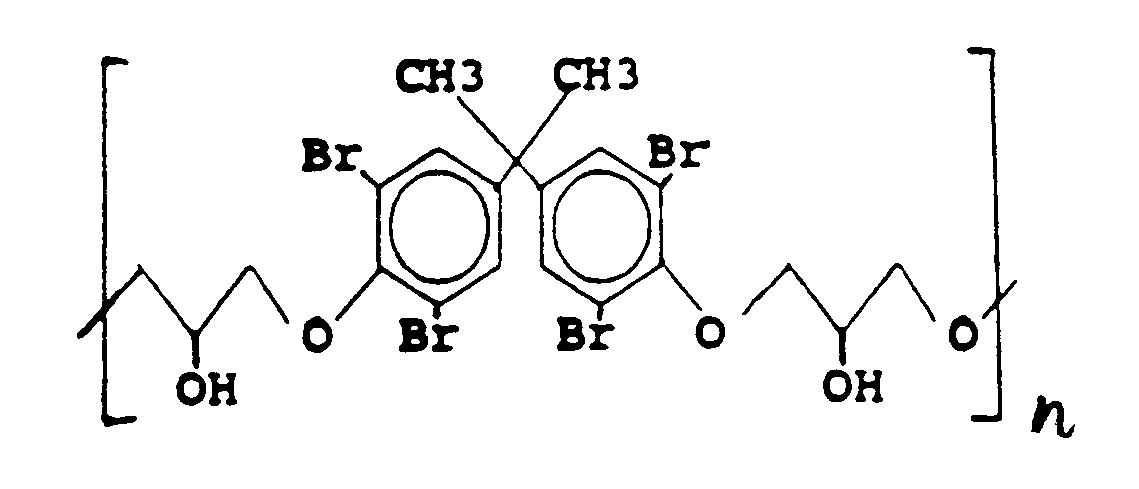
where n is sufficient for the molecular weight of the oligomeric or polymeric residue to be about 700 to 40,000.
where n is sufficient for the molecular weight of the oligomeric or polymeric residue to be about 700 to 40,000.
5. The process of Claim 4 wherein the molecular weight is about 700 to 10,000.
6. The process of Claim 4 or 5 wherein the weight percent based on the polyimide or polyamic
precursor in the dope is about 5% to 30%.
7. The process of any one of Claims 1 to 6 wherein the polyimide consists essentially
of repeating units of the formula

wherein
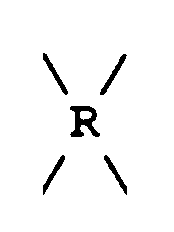
is selected from

where RI is

or alkylene groups of 1 to 5 carbon atoms, where -RII- is
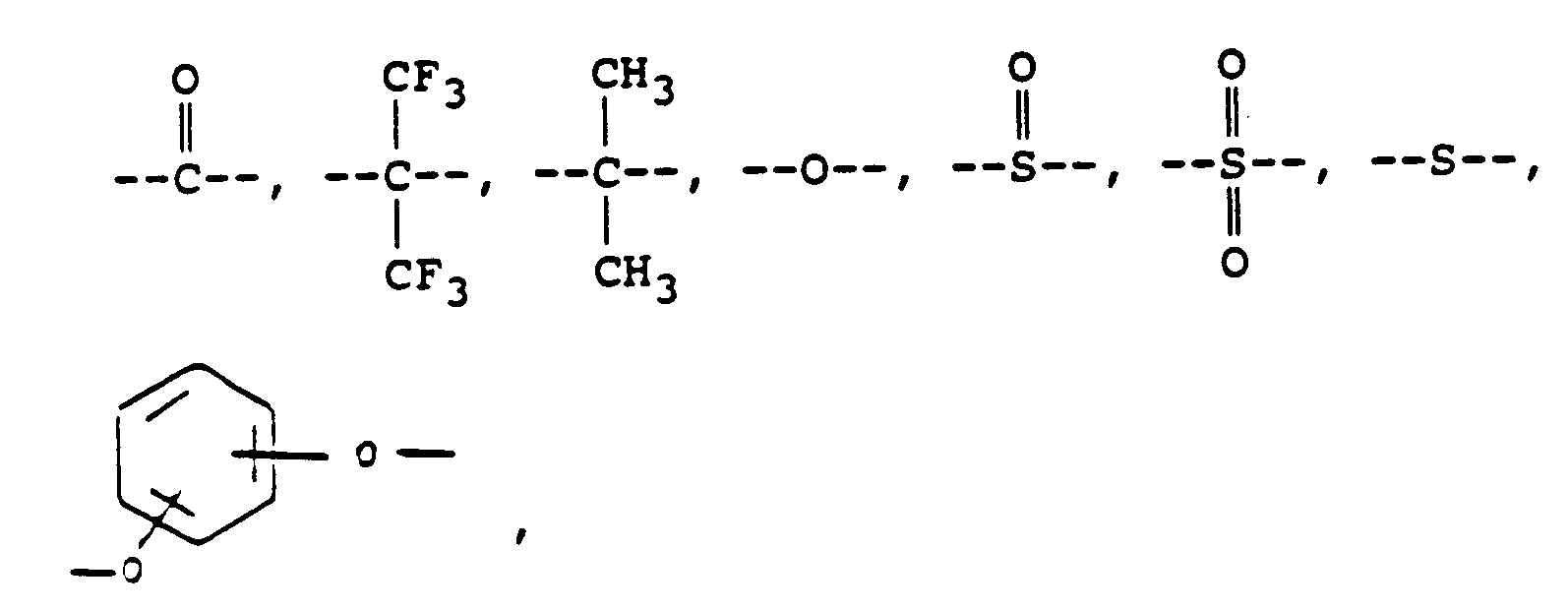
or alkylene groups of 1 to 5 carbon atoms; Ar is

or mixtures thereof, where -RIII is
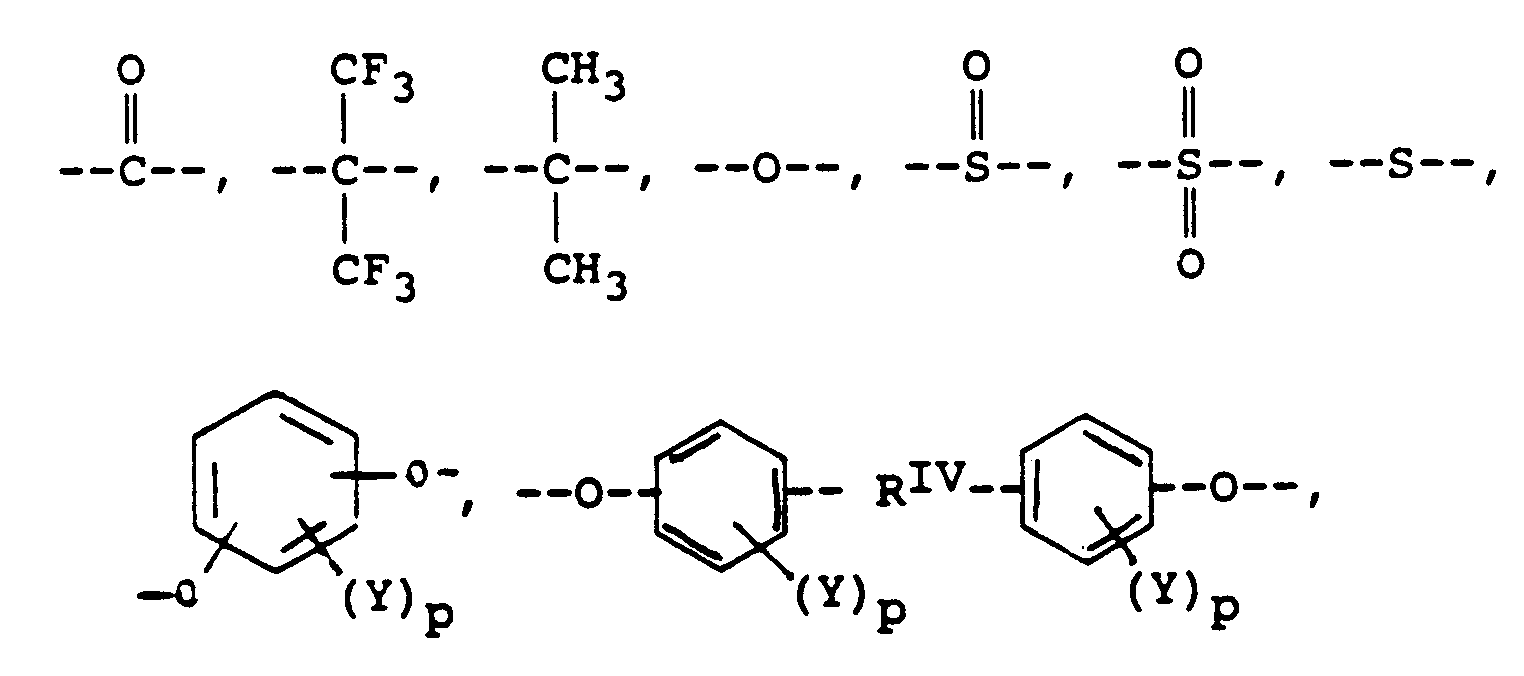
or alkylene groups of 1 to 5 carbon atoms, where -RIV- is
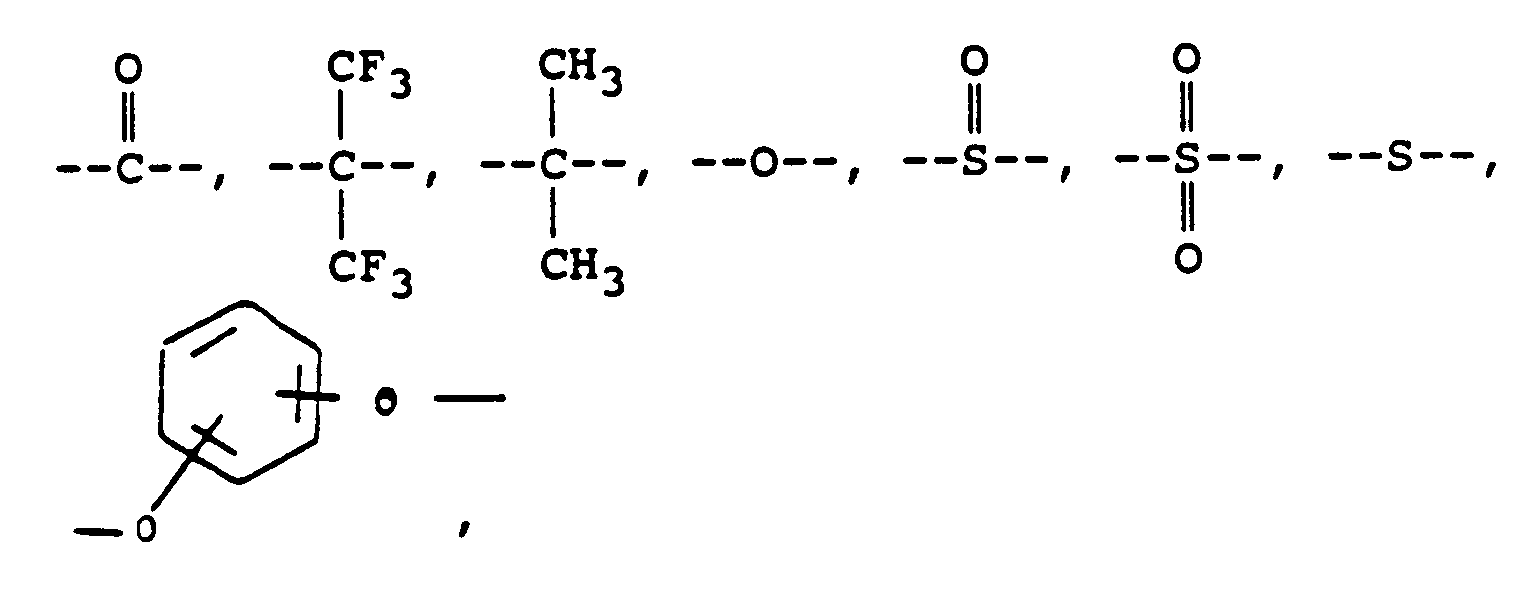
or alkylene groups of 1 to 5 carbon atoms, -X-, -X₁-, - X₂-, and -X₃- independently are alkyl groups of 1 to 5 carbon atoms, alkoxy groups of 1 to 5 carbon atoms, phenyl or phenoxy groups, -Y-, -Y₁-, -Y₂- and -Y₃-independently are -H, -X-, -X₁-, -X₂-, -X₃- or halogen, and where RV, RVI, and RVII are independently -H or lower alkyl having from 1 to 6 carbon atoms; -Ar'- is

or mixtures thereof where -RII-, RV, RVI, and RVII have the above-defined meanings, m and n are fractions from 0 to 1.0, where

, and p is 0 to 3.
wherein
is selected from
where RI is
or alkylene groups of 1 to 5 carbon atoms, where -RII- is
or alkylene groups of 1 to 5 carbon atoms; Ar is
or mixtures thereof, where -RIII is
or alkylene groups of 1 to 5 carbon atoms, where -RIV- is
or alkylene groups of 1 to 5 carbon atoms, -X-, -X₁-, - X₂-, and -X₃- independently are alkyl groups of 1 to 5 carbon atoms, alkoxy groups of 1 to 5 carbon atoms, phenyl or phenoxy groups, -Y-, -Y₁-, -Y₂- and -Y₃-independently are -H, -X-, -X₁-, -X₂-, -X₃- or halogen, and where RV, RVI, and RVII are independently -H or lower alkyl having from 1 to 6 carbon atoms; -Ar'- is
or mixtures thereof where -RII-, RV, RVI, and RVII have the above-defined meanings, m and n are fractions from 0 to 1.0, where
, and p is 0 to 3.
8. A gas separation membrane comprising a blend of an aromatic polymer having an imide
linkage in its backbone and sufficient oligomeric or polymeric residue, the polymerisation
product of a compound of the following structure:

where Ar represents a divalent aromatic group of the form

where RVIII is a direct bond or

and said residue being of a sufficient molecular weight to be soluble in the gas separation membrane.
where Ar represents a divalent aromatic group of the form
where RVIII is a direct bond or
and said residue being of a sufficient molecular weight to be soluble in the gas separation membrane.
9. The gas separation membrane of claim 8 wherein the resulting repeating units are substituted
with halogen atoms at all positions ortho to the glycidyl ether groups.
10. The membrane of Claims 9 wherein the halogen atoms are bromine atoms.
11. The membrane of Claim 10 wherein the oligomeric or polymeric residue has n repeating
units of the form:
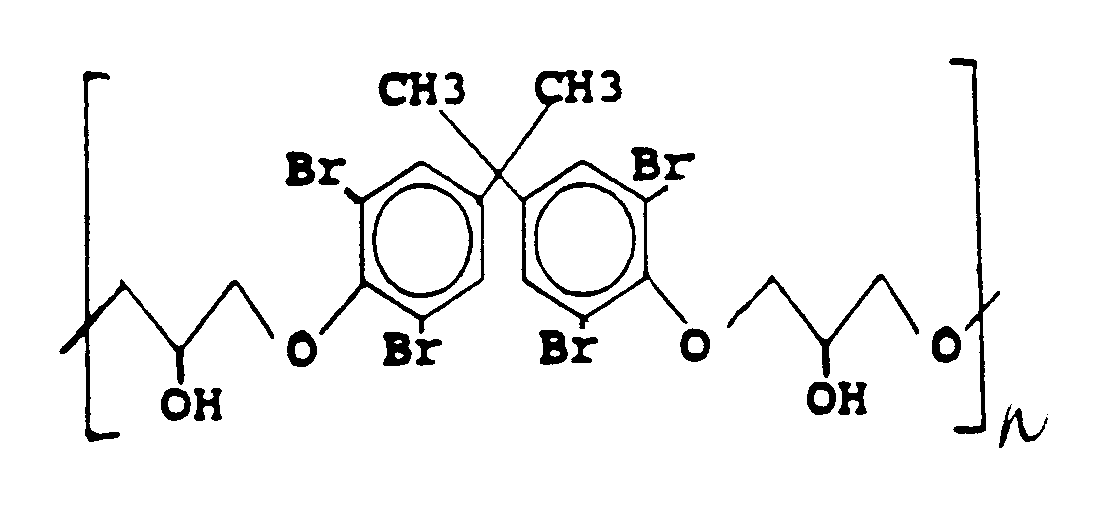
where n is sufficient for the molecular weight of the oligomeric or polymeric residue to be about 700 to 40,000.
where n is sufficient for the molecular weight of the oligomeric or polymeric residue to be about 700 to 40,000.
12. The membrane of Claim 11 wherein the molecular weight is about 700 to 10 000.
13. The membrane of Claim 11 or 12 wherein the weight percent based on the aromatic polyimide
is about 5% to 30%.
14. The membrane of any one of Claims 8 to 13 wherein the polyimide consists essentially
of repeating units of the formula

wherein
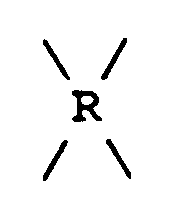
is selected from

where RI is
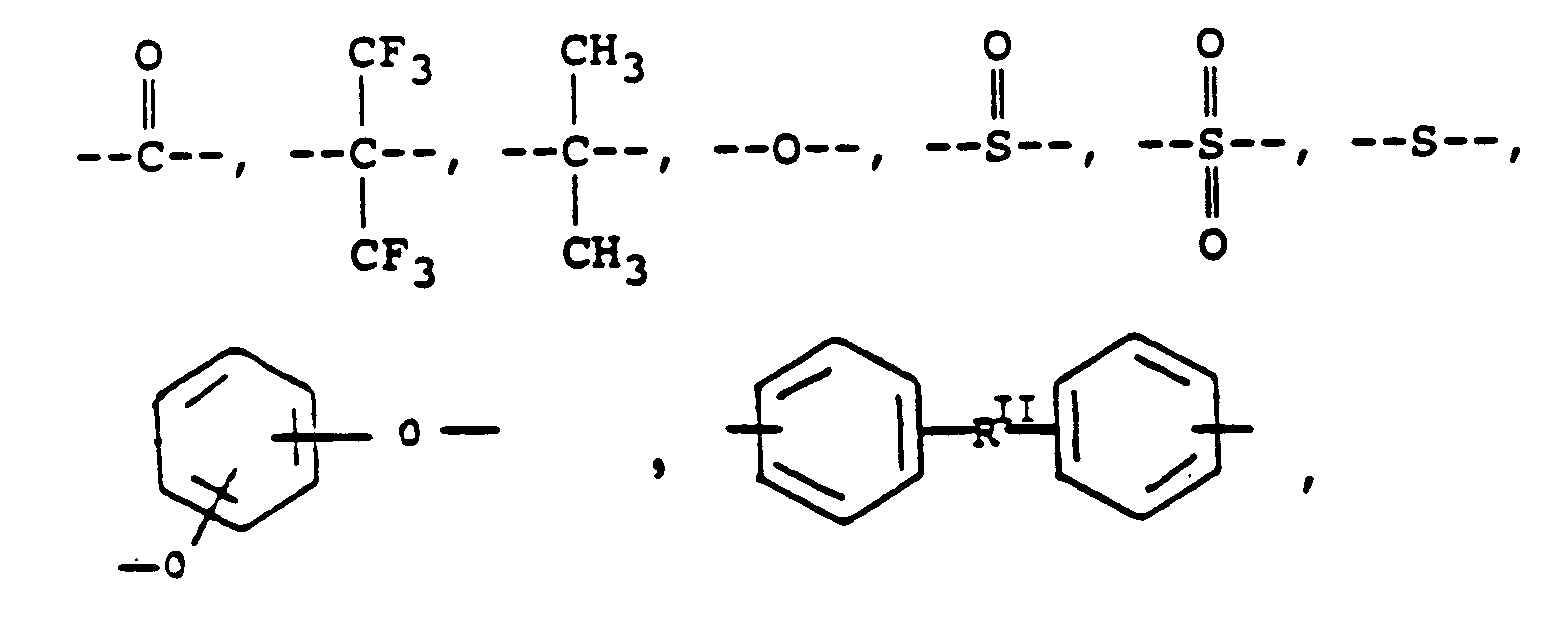
or alkylene groups of 1 to 5 carbon atoms, where -RII- is
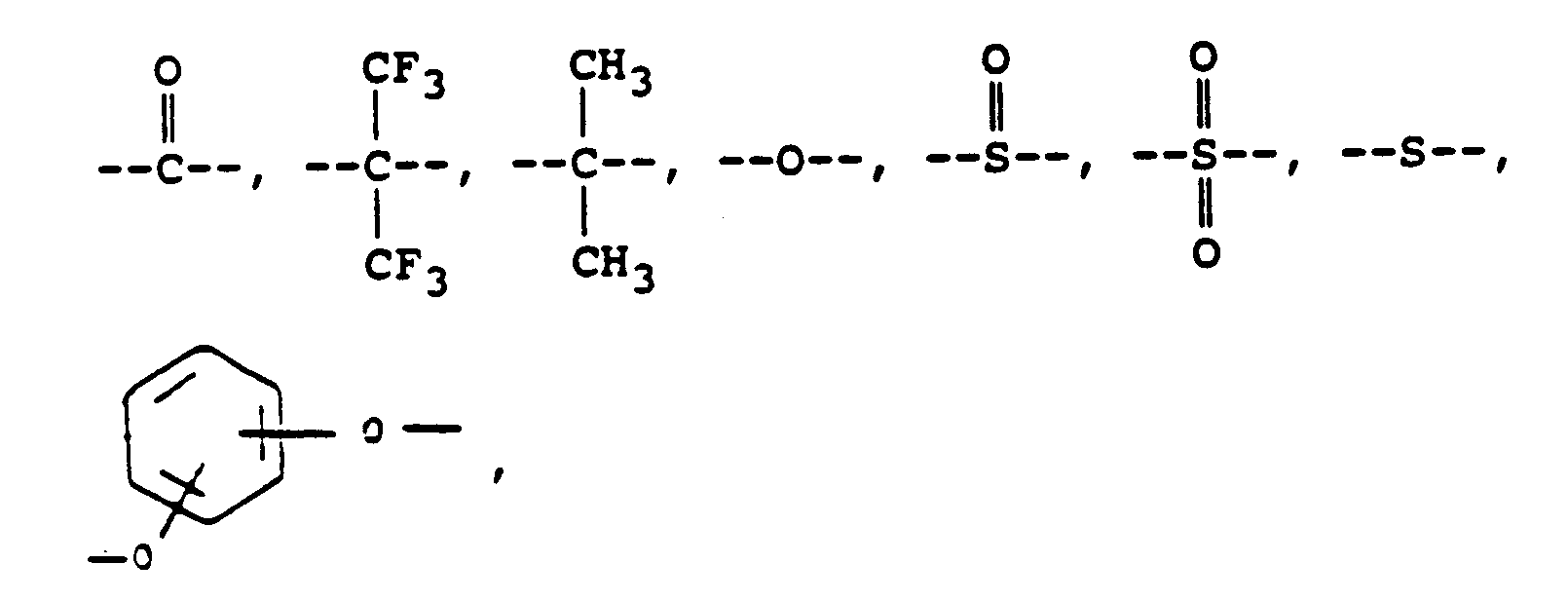
or alkylene groups of 1 to 5 carbon atoms; Ar is
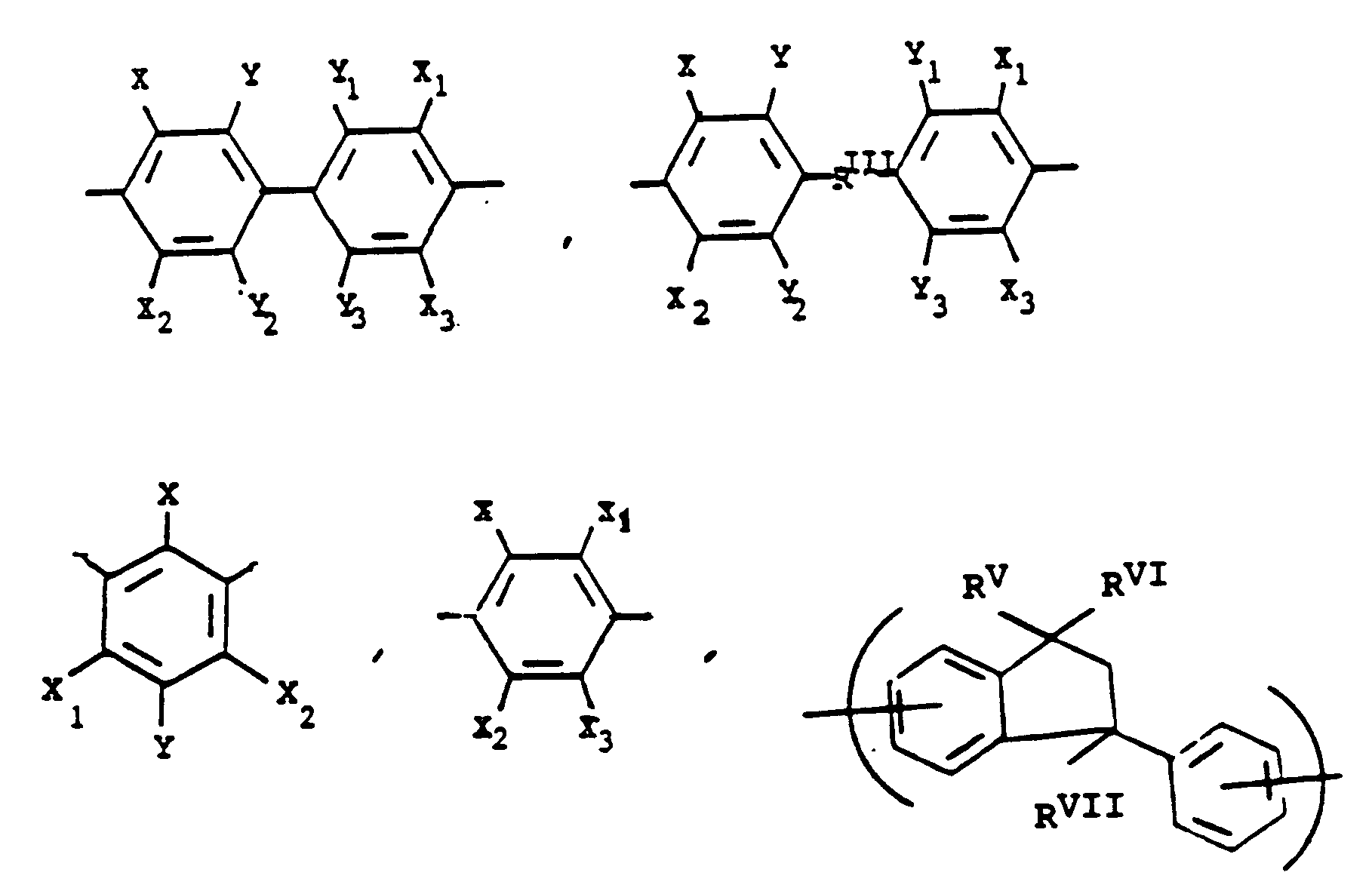
or mixtures thereof, where -RIIIis
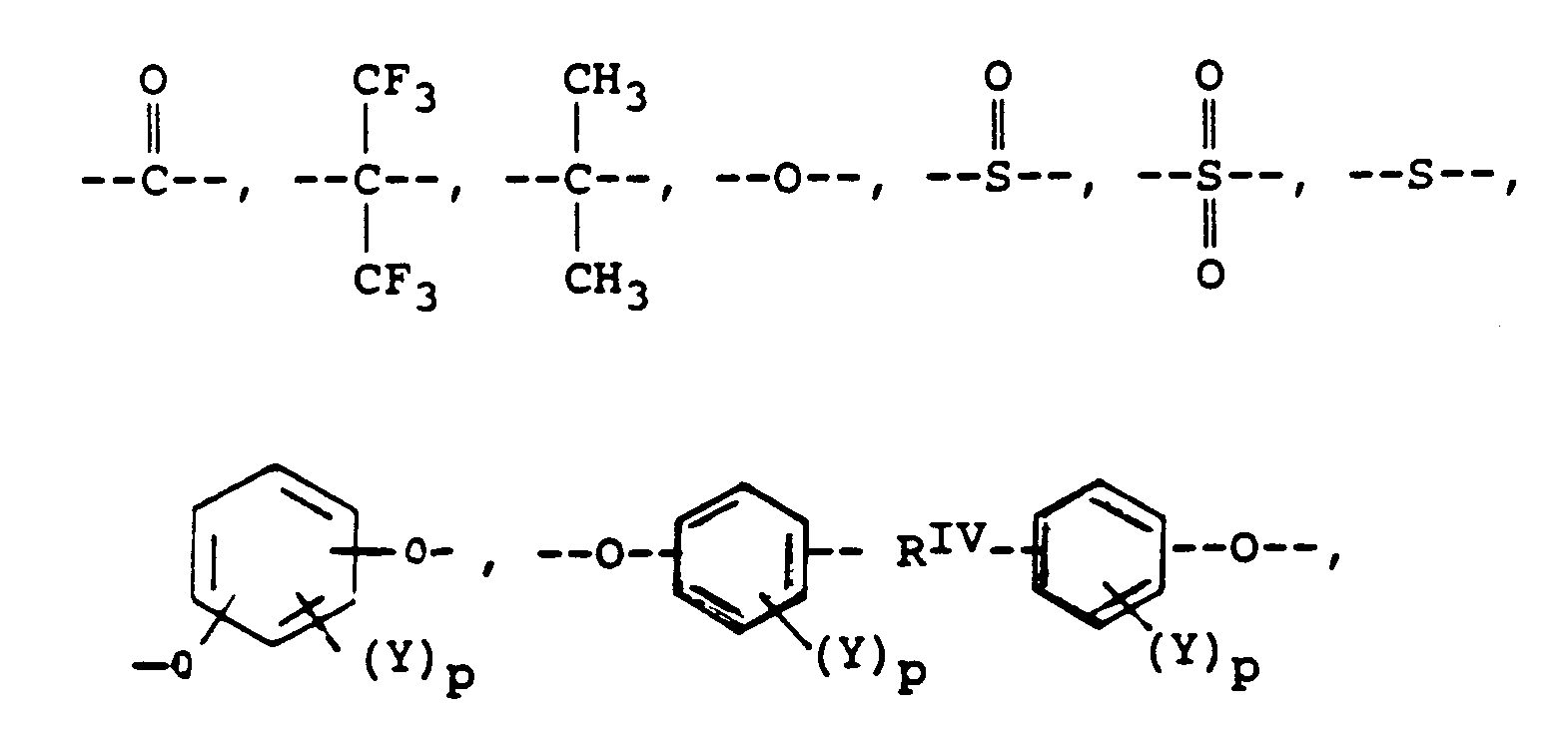
or alkylene groups of 1 to 5 carbon atoms, where -RIV- is
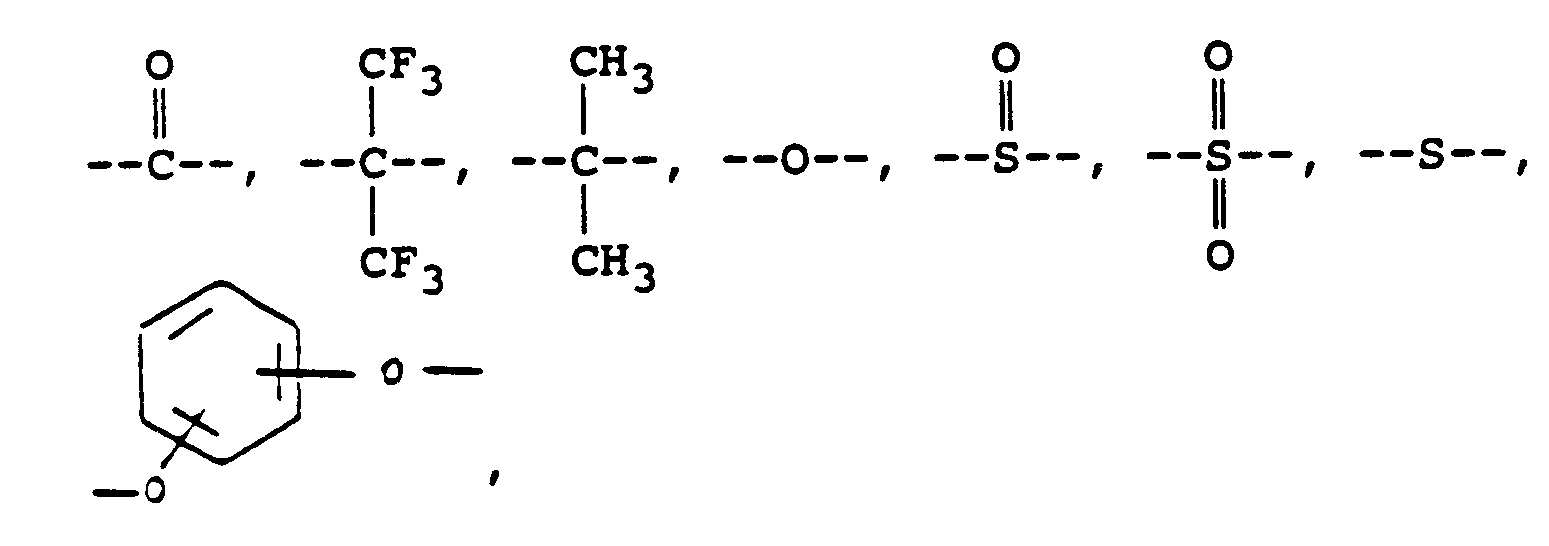
or alkylene groups of 1 to 5 carbon atoms, -X-, -X₁-, -X₂-, and -X₃- independently are alkyl groups of 1 to 5 carbon atoms, alkoxy groups of 1 to 5 carbon atoms, phenyl or phenoxy groups, -Y-, -Y₁-, -Y₂- and -Y₃-independently are -H, -X-, -X₁-, -X₂-, -X₃- or halogen, and where RV, RVI, and RVII are independently -H or lower alkyl having from 1 to 6 carbon atoms; -Ar′- is

or mixtures thereof where -RII-, RV, RVI, and RVII have the above-defined meanings, m and n are fractions from 0 to 1.0, where

, and p is 0 to 3.
wherein
is selected from
where RI is
or alkylene groups of 1 to 5 carbon atoms, where -RII- is
or alkylene groups of 1 to 5 carbon atoms; Ar is
or mixtures thereof, where -RIIIis
or alkylene groups of 1 to 5 carbon atoms, where -RIV- is
or alkylene groups of 1 to 5 carbon atoms, -X-, -X₁-, -X₂-, and -X₃- independently are alkyl groups of 1 to 5 carbon atoms, alkoxy groups of 1 to 5 carbon atoms, phenyl or phenoxy groups, -Y-, -Y₁-, -Y₂- and -Y₃-independently are -H, -X-, -X₁-, -X₂-, -X₃- or halogen, and where RV, RVI, and RVII are independently -H or lower alkyl having from 1 to 6 carbon atoms; -Ar′- is
or mixtures thereof where -RII-, RV, RVI, and RVII have the above-defined meanings, m and n are fractions from 0 to 1.0, where
, and p is 0 to 3.
1. Verbessertes Verfahren zur Herstellung von Gastrennmembranen von aromatischen Polymeren,
die Imidbindungen in ihrer Hauptkette aufweisen, durch Spinnen einer Lösung eines
aromatischen Polyimids oder einer Polyamsäurevorstufe zu dem genannten aromatischen
Polyimid in einem Lösungsmittel, wobei die Verbesserung die Zugabe einer ausreichenden
Menge eines oligomeren oder polymeren Restes zu der Spinnlösung umfaßt, wobei der
oligomere oder polymere Rest das Polymerisationsprodukt einer Verbindung der folgenden
Struktur darstellt:

worin Ar für eine zweiwertige aromatische Gruppe der Form
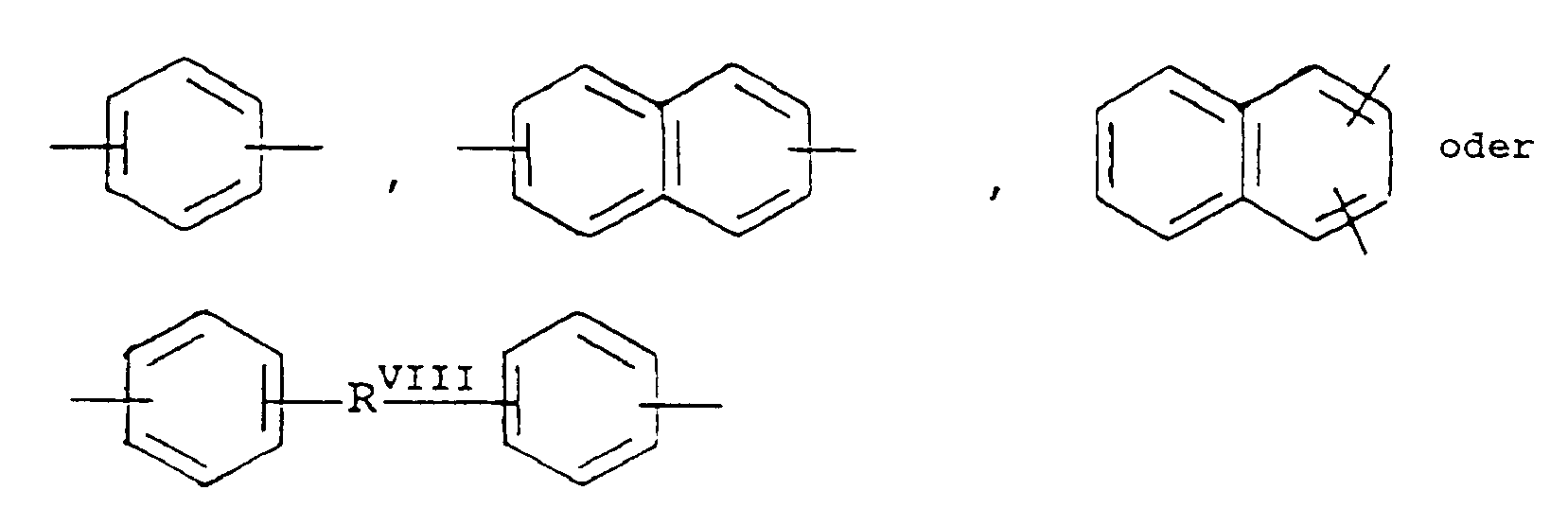
steht, worin RVIII eine direkte Bindung oder
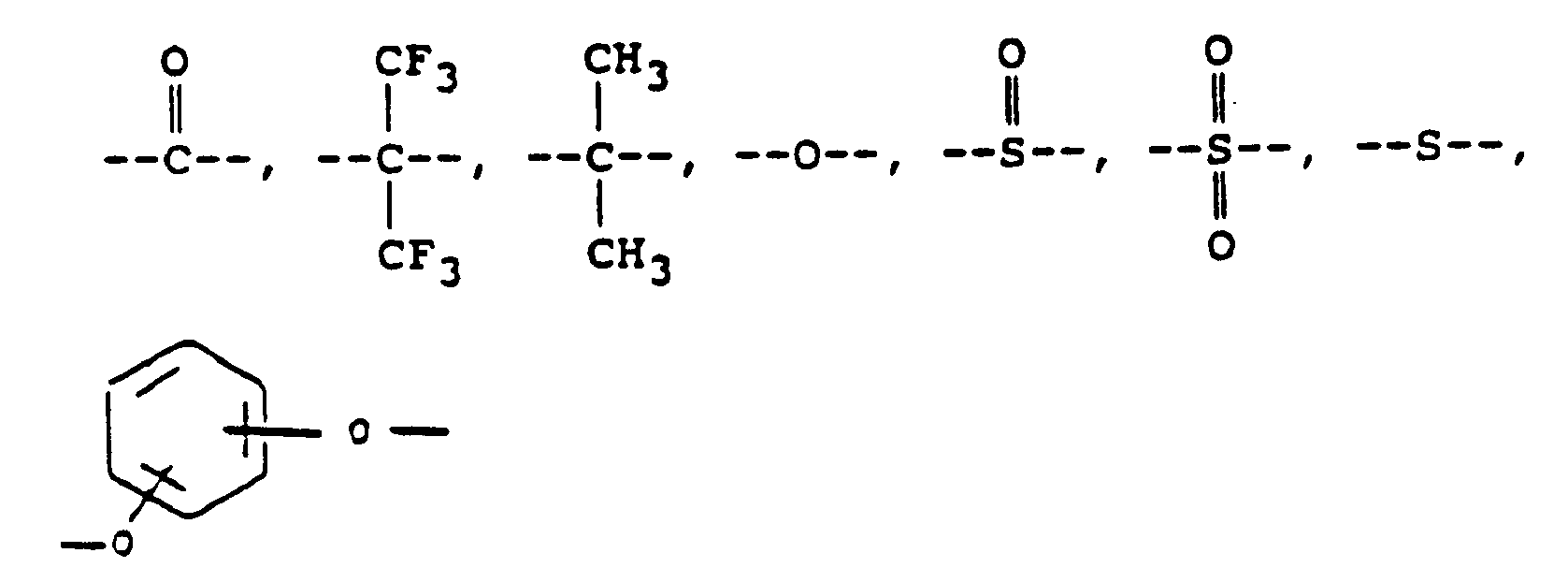
darstellt, und der genannte Rest ein ausreichendes Molekulargewicht besitzt, so daß er unter den Verfahrensbedingungen in der aromatischen Polyimid- oder Polyamvorstufe und in dem Lösungsmittel und in der hergestellten Gastrennmembran löslich ist, wobei der genannte Rest während des Verfahrens nicht vollständig aus der Membran extrahiert wird.
worin Ar für eine zweiwertige aromatische Gruppe der Form
steht, worin RVIII eine direkte Bindung oder
darstellt, und der genannte Rest ein ausreichendes Molekulargewicht besitzt, so daß er unter den Verfahrensbedingungen in der aromatischen Polyimid- oder Polyamvorstufe und in dem Lösungsmittel und in der hergestellten Gastrennmembran löslich ist, wobei der genannte Rest während des Verfahrens nicht vollständig aus der Membran extrahiert wird.
2. Verfahren nach Anspruch 1, bei dem die resultierenden Repetiereinheiten mit Halogenatomen
an allen Positionen in ortho-Stellung zu den Glycidylethergruppen substituiert sind.
3. Verfahren nach Anspruch 2, bei dem die Halogenatome Bromatome sind.
4. Verfahren nach Anspruch 3, bei dem der oligomere oder polymere Rest n Repetiereinheiten
der Form

aufweist, worin n ausreicht, so daß das Molekulargewicht des oligomeren oder polymeren Restes etwa 700 bis 40 000 beträgt.
aufweist, worin n ausreicht, so daß das Molekulargewicht des oligomeren oder polymeren Restes etwa 700 bis 40 000 beträgt.
5. Verfahren nach Anspruch 4, bei dem das Molekulargewicht etwa 700 bis 10 000 beträgt.
6. Verfahren nach Anspruch 4 oder 5, bei dem der Gewichtsprozentsatz auf der Grundlage
der Polyimid- oder Polyamvorstufe in der Spinnlösung etwa 5 % bis 30 % beträgt.
7. Verfahren nach einem der Ansprüche 1 bis 6, bei dem das Polyimid im wesentlichen aus
Repetiereinheiten der Formel

besteht, worin

ausgewählt wird aus

worin RI für
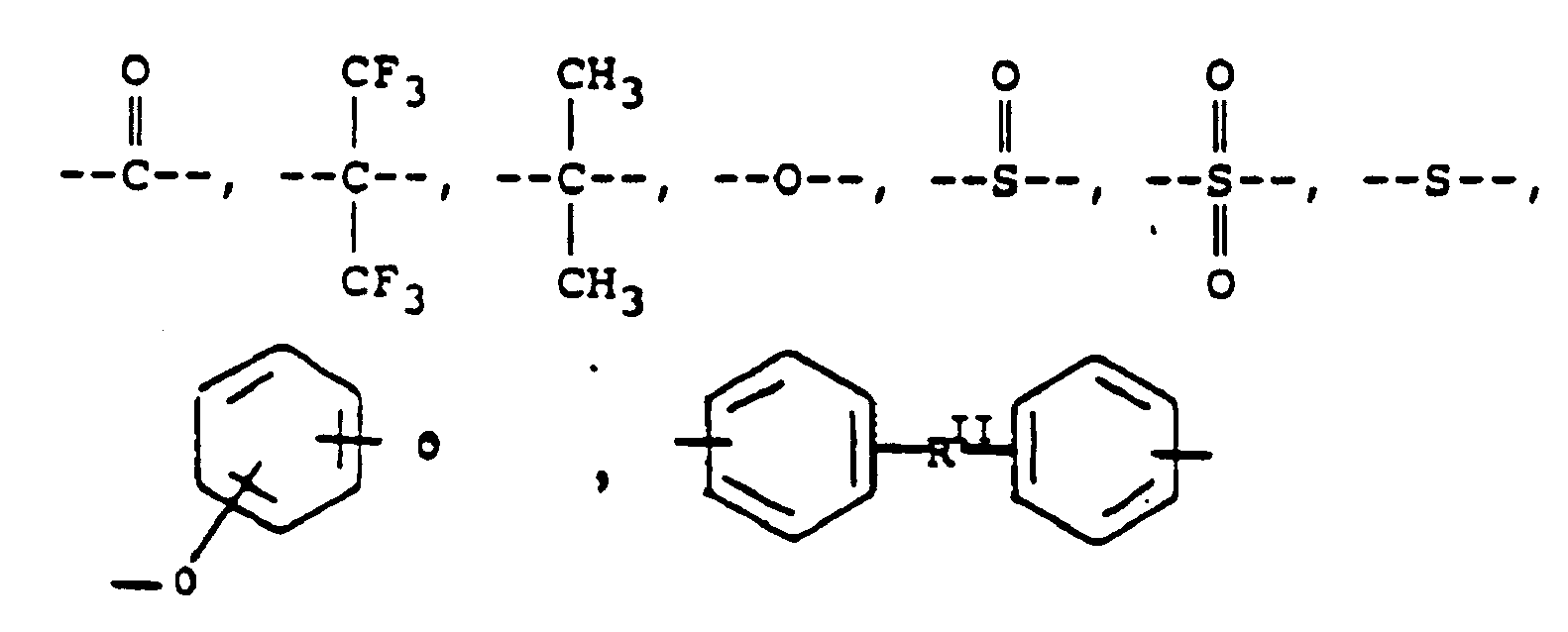
oder für Alkylengruppen mit 1 bis 5 Kohlenstoffatomen steht, worin RII für

oder
Alkylengruppen mit 1 bis 5 Kohlenstoffatomen steht, Ar für
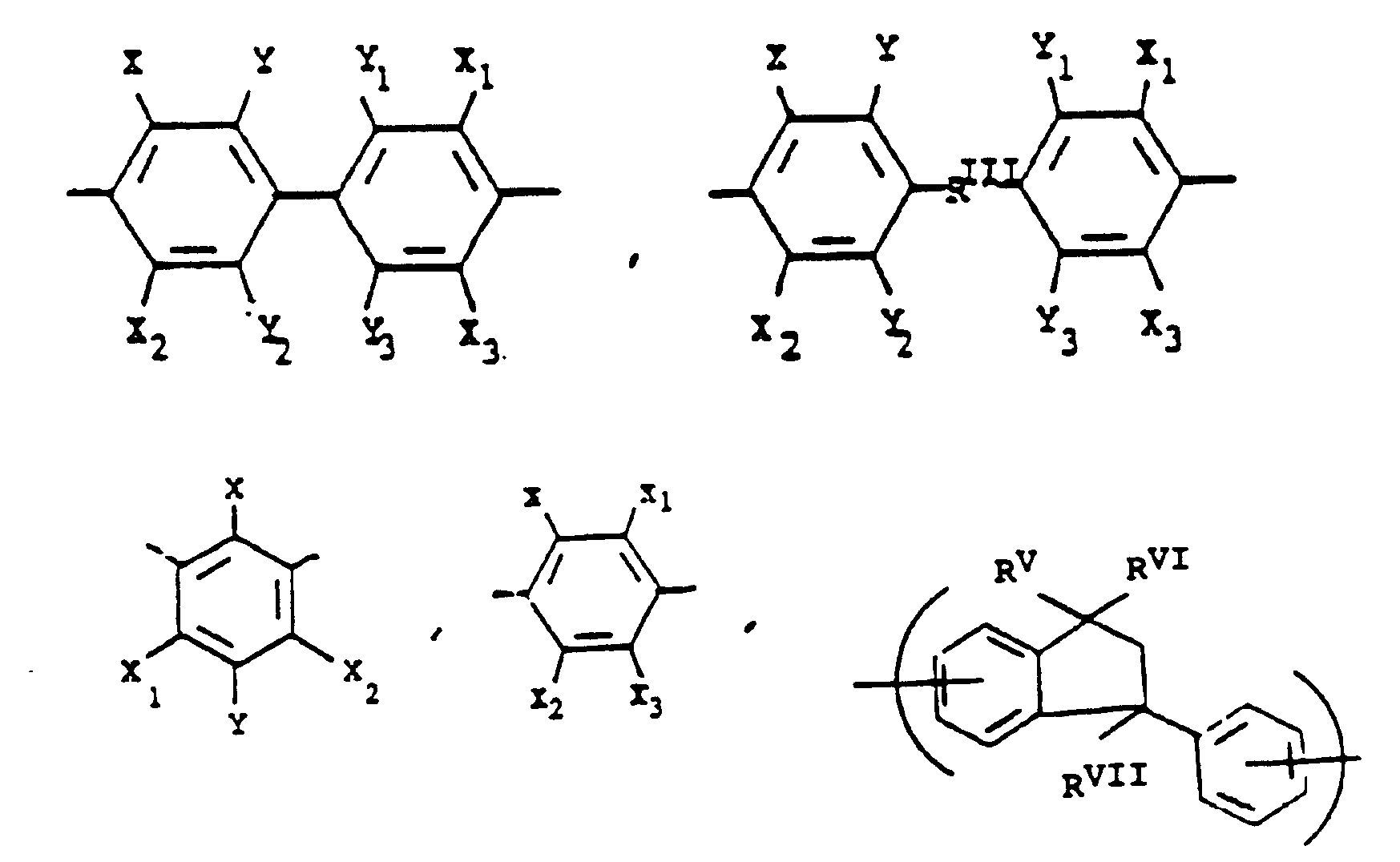
oder Gemische davon steht, worin -RIII für

oder Alkylengruppen mit 1 bis 5 Kohlenstoffatomen steht, worin -RIV- für

oder
Alkylengruppen mit 1 bis 5 Kohlenstoffatomen steht, -X-, -X₁-, -X₂- und -X₃- unabhängig für Alkylgruppen mit 1 bis 5 Kohlenstoffatomen, Alkoxy-gruppen mit 1 bis 5 Kohlenstoffatomen, Phenyl- oder Phenoxygruppen stehen, -Y-, -Y₁-, -Y₂- und -Y₃- unab-hängig für -H, -X-, -X₁-, -X₂-, -X₃- oder Halogen stehen und worin RV, RVI und RVII unabhängig für -H oder Niedrigalkyl mit 1 bis 6 Kohlenstoffatomen stehen, -Ar'- für

oder Gemische davon steht, worin -RII-, RV, RVI und RVII die oben gegebenen Bedeutungen besitzen, m und n Brüche von 0 bis 1,0 darstellen, worin

und p eine Zahl von 0 bis 3 bedeutet.
besteht, worin
ausgewählt wird aus
worin RI für
oder für Alkylengruppen mit 1 bis 5 Kohlenstoffatomen steht, worin RII für
oder
Alkylengruppen mit 1 bis 5 Kohlenstoffatomen steht, Ar für
oder Gemische davon steht, worin -RIII für
oder Alkylengruppen mit 1 bis 5 Kohlenstoffatomen steht, worin -RIV- für
oder
Alkylengruppen mit 1 bis 5 Kohlenstoffatomen steht, -X-, -X₁-, -X₂- und -X₃- unabhängig für Alkylgruppen mit 1 bis 5 Kohlenstoffatomen, Alkoxy-gruppen mit 1 bis 5 Kohlenstoffatomen, Phenyl- oder Phenoxygruppen stehen, -Y-, -Y₁-, -Y₂- und -Y₃- unab-hängig für -H, -X-, -X₁-, -X₂-, -X₃- oder Halogen stehen und worin RV, RVI und RVII unabhängig für -H oder Niedrigalkyl mit 1 bis 6 Kohlenstoffatomen stehen, -Ar'- für
oder Gemische davon steht, worin -RII-, RV, RVI und RVII die oben gegebenen Bedeutungen besitzen, m und n Brüche von 0 bis 1,0 darstellen, worin
und p eine Zahl von 0 bis 3 bedeutet.
8. Gastrennmembran, umfassend eine Mischung aus einem aromatischen Polymeren mit einer
Imidbindung in seiner Hauptkette und einer ausreichenden Menge eines oligomeren oder
polymeren Restes, des Polymerisationsproduktes einer Verbindung der folgenden Struktur:

worin Ar für eine zweiwertige aromatische Gruppe der Form

steht,
worin RVIII eine direkte Bindung oder

darstellt, und der genannte Rest ein ausreichendes Molekulargewicht besitzt, so daß er in der Gastrennmembran löslich ist.
worin Ar für eine zweiwertige aromatische Gruppe der Form
steht,
worin RVIII eine direkte Bindung oder
darstellt, und der genannte Rest ein ausreichendes Molekulargewicht besitzt, so daß er in der Gastrennmembran löslich ist.
9. Gastrennmembran nach Anspruch 8, worin die resultierenden Repetiereinheiten an allen
Positionen in ortho-Stellung zu den Glycidylethergruppen mit Halogenatomen substituiert
sind.
10. Membran nach Anspruch 9, worin die Halogenatome Bromatome darstellen.
11. Membran nach Anspruch 10, worin der oligomere oder polymere Rest n Repetiereinheiten
der Form
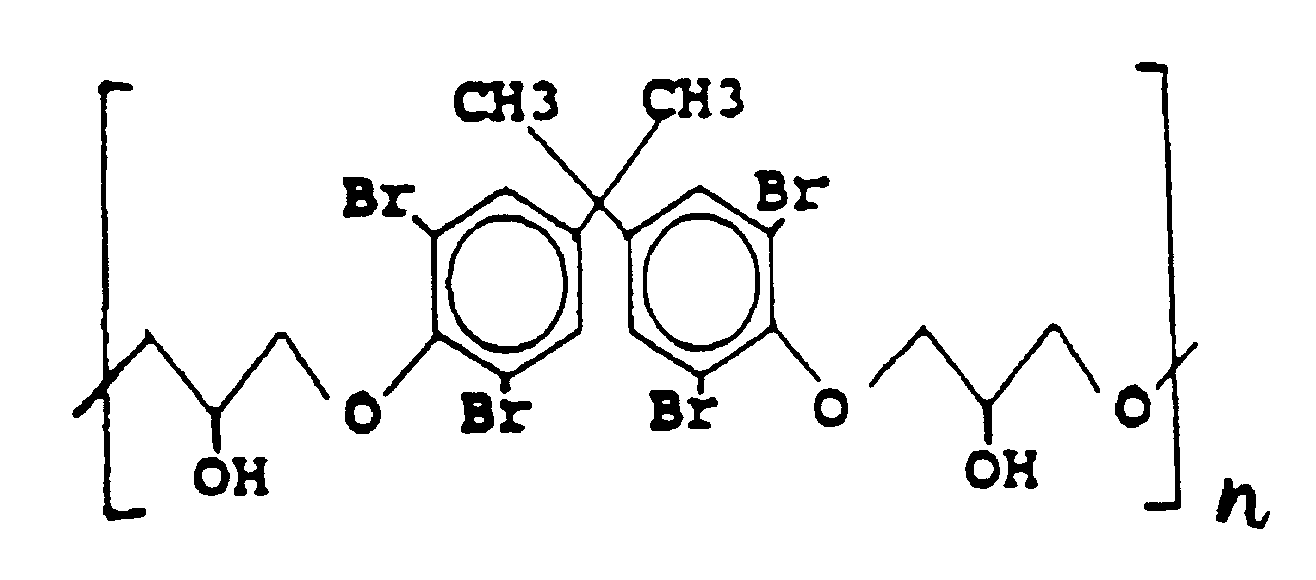
aufweist, worin n ausreicht, so daß das Molekulargewicht des oligomeren oder polymeren Restes etwa 700 bis 40 000 beträgt.
aufweist, worin n ausreicht, so daß das Molekulargewicht des oligomeren oder polymeren Restes etwa 700 bis 40 000 beträgt.
12. Membran nach Anspruch 11, worin das Molekulargewicht etwa 700 bis 10 000 beträgt.
13. Membran nach Anspruch 11 oder 12, worin der Gewichtsprozentsatz auf der Grundlage
des aromatischen Polyimids etwa 5 % bis 30 % beträgt.
14. Membran nach einem der Ansprüche 8 bis 13, worin das Polyimid im wesentlichen aus
Repetiereinheiten der Formel

besteht, worin

ausgewählt wird aus

worin RI für
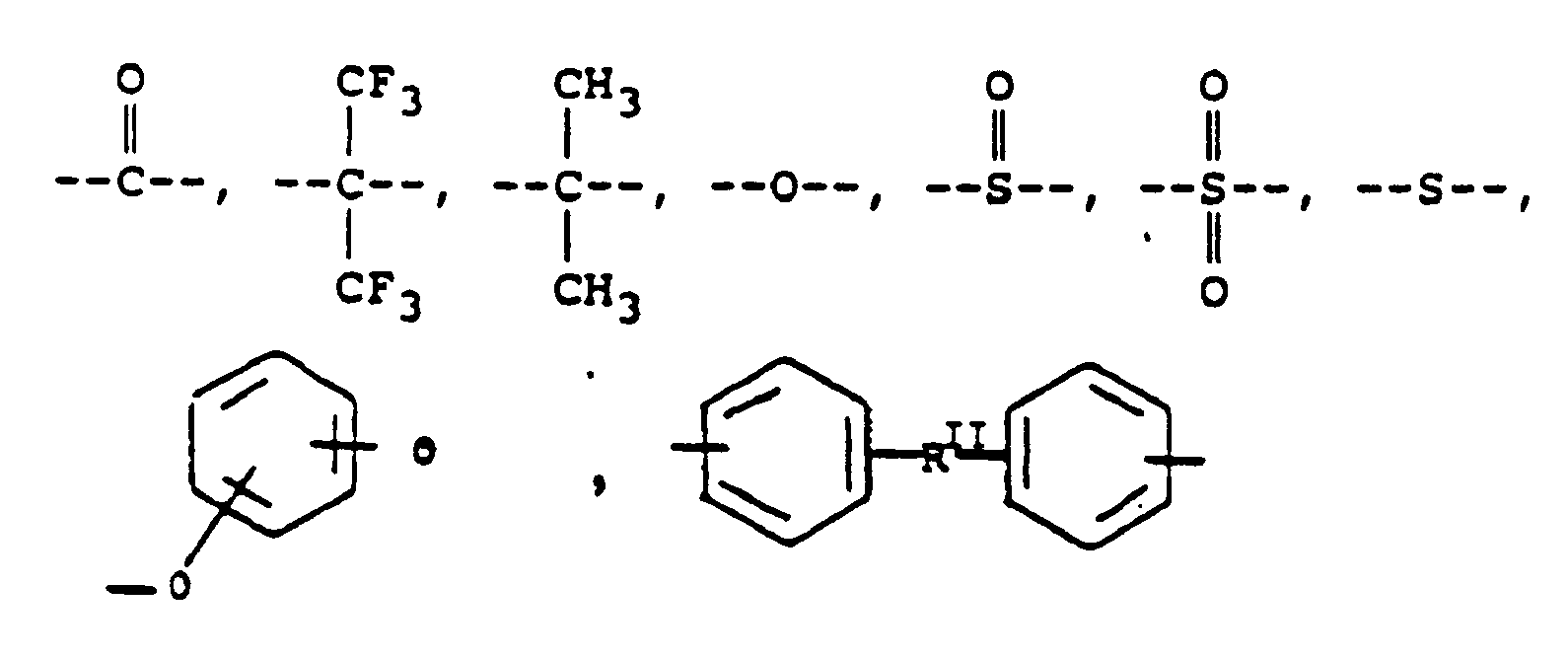
oder Alkylengruppen mit 1 bis 5 Kohlenstoffatomen steht, worin RII für

oder Alkylengruppen mit 1 bis 5 Kohlenstoffatomen steht, Ar für


oder Gemische davon steht, worin -RIII für

oder Alkylengruppen mit 1 bis 5 Kohlenstoffatomen steht, worin -RIV- für

oder Alkylengruppen mit 1 bis 5 Kohlenstoffatomen steht, -X-, -X₁-, -X₂- und -X₃- unabhängig für Alkylgruppen mit 1 bis 5 Kohlenstoffatomen, Alkoxygruppen mit 1 bis 5 Kohlenstoffatomen, Phenyl- oder Phenoxygruppen stehen, -Y-, -Y₁-, -Y₂- und -Y₃- unabhängig für -H, -X-, -X₁-, -X₂-, -X₃- oder Halogen stehen und worin RV, RVI und RVII unabhängig für -H oder Niedrigalkyl mit 1 bis 6 Kohlenstoffatomen stehen, -Ar'- für

oder Gemische davon steht, worin -RII-, RV, RVI und RVII die oben festgelegten Bedeutungen besitzen, m und n Brüche von 0 bis 1,0 darstellen, worin

und p eine Zahl von 0 bis 3 bedeutet.
besteht, worin
ausgewählt wird aus
worin RI für
oder Alkylengruppen mit 1 bis 5 Kohlenstoffatomen steht, worin RII für
oder Alkylengruppen mit 1 bis 5 Kohlenstoffatomen steht, Ar für
oder Gemische davon steht, worin -RIII für
oder Alkylengruppen mit 1 bis 5 Kohlenstoffatomen steht, worin -RIV- für
oder Alkylengruppen mit 1 bis 5 Kohlenstoffatomen steht, -X-, -X₁-, -X₂- und -X₃- unabhängig für Alkylgruppen mit 1 bis 5 Kohlenstoffatomen, Alkoxygruppen mit 1 bis 5 Kohlenstoffatomen, Phenyl- oder Phenoxygruppen stehen, -Y-, -Y₁-, -Y₂- und -Y₃- unabhängig für -H, -X-, -X₁-, -X₂-, -X₃- oder Halogen stehen und worin RV, RVI und RVII unabhängig für -H oder Niedrigalkyl mit 1 bis 6 Kohlenstoffatomen stehen, -Ar'- für
oder Gemische davon steht, worin -RII-, RV, RVI und RVII die oben festgelegten Bedeutungen besitzen, m und n Brüche von 0 bis 1,0 darstellen, worin
und p eine Zahl von 0 bis 3 bedeutet.
1. Un procédé perfectionné pour la réalisation de membranes de séparation de gaz en polymères
aromatiques dont le squelette comporte des liaisons imide à partir d'une solution
de filage d'un polyimide aromatique ou d'un acide polyamique précurseur dudit polyimide
aromatique dans un solvant, dans lequel le perfectionnement comprend l'addition à
la solution de filage d'assez de résidu oligomère ou polymère, le résidu étant le
produit de polymérisation d'un composé ayant pour structure :

où Ar représente un groupe aromatique divalent de la forme

RVIII étant une liaison directe ou un groupe

et ledit résidu étant d'un poids moléculaire suffisant pour être soluble dans le polyimide aromatique ou le précurseur acide polyamique et dans le solvant dans les conditions opératoires et dans la membrane de séparation de gaz, ledit résidu n'étant pas extrait totalement de la membrane pendant le déroulement du procédé.
où Ar représente un groupe aromatique divalent de la forme
RVIII étant une liaison directe ou un groupe
et ledit résidu étant d'un poids moléculaire suffisant pour être soluble dans le polyimide aromatique ou le précurseur acide polyamique et dans le solvant dans les conditions opératoires et dans la membrane de séparation de gaz, ledit résidu n'étant pas extrait totalement de la membrane pendant le déroulement du procédé.
2. Le procédé de la revendication 1 dans lequel les motifs répétitifs sont substitués
par des atomes d'halogène dans toutes les positions en ortho par rapport aux groupes
glycidyloxy.
3. Le procédé de la revendication 2 dans lequel les atomes d'halogène sont des atomes
de brome.
4. Le procédé de la revendication 3 dans lequel le résidu oligomère ou polymère renferme
n motifs répétitifs de la forme

n étant suffisant pour que le poids moléculaire du résidu oligomère ou polymère soit d'environ 700 à 40 000.
n étant suffisant pour que le poids moléculaire du résidu oligomère ou polymère soit d'environ 700 à 40 000.
5. Le procédé de la revendication 4 dans lequel le poids moléculaire est d'environ 700
à 10 000.
6. Le procédé de la revendication 4 ou 5 dans lequel le pourcentage pondéral basé sur
le polyimide ou le précurseur polyamique dans la solution de filage est d'environ
5 à 30 %.
7. Le procédé de l'une quelconque des revendications 1 à 6 dans lequel le polyimide est
constitué essentiellement de motifs répétitifs de formule

dans laquelle

est choisi parmi

où RI est

ou des groupes alkylènes comptant 1 à 5 atomes de carbone, où -RII- est

ou des groupes alkylènes comptant 1 à 5 atomes de carbone ; Ar est

ou leurs mélanges, où -RIII- est

ou des groupes alkylènes comptant 1 à 5 atomes de carbone, où -RIV est

ou des groupes alkylènes comptant 1 à 5 atomes de carbone, -X-, -X₁-, -X₂- et -X₃- sont indépendamment les uns des autres des groupes alkyles comptant 1 à 5 atomes de carbone, des groupes alcoxy comptant 1 à 5 atomes de carbone ou des groupes phényle ou phénoxy, -Y-, -Y₁-, -Y₂-et -Y₃- sont indépendamment les uns des autres des groupes -H, -X-, -X₁-, -X₂- ou -X₃- ou des atomes d'halogène, et où RV, RVI et RVII sont indépendamment les uns des autres un atome d'hydrogène ou un groupe alkyle inférieur comptant 1 à 6 atomes de carbone ; -Ar'- est
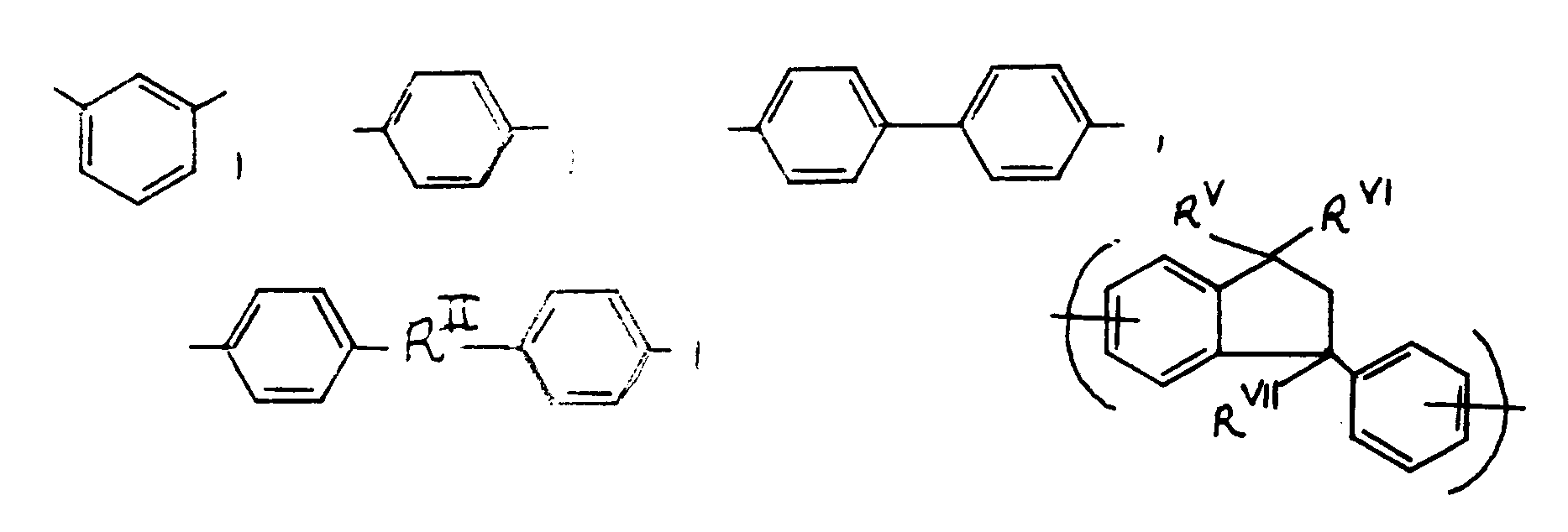
ou leurs mélanges où -RII- RV, RVI et RVII répondent aux mêmes définitions que plus haut, m et n sont des fractions de 0 à 1,0, où

et p est 0 à 3.
dans laquelle
est choisi parmi
où RI est
ou des groupes alkylènes comptant 1 à 5 atomes de carbone, où -RII- est
ou des groupes alkylènes comptant 1 à 5 atomes de carbone ; Ar est
ou leurs mélanges, où -RIII- est
ou des groupes alkylènes comptant 1 à 5 atomes de carbone, où -RIV est
ou des groupes alkylènes comptant 1 à 5 atomes de carbone, -X-, -X₁-, -X₂- et -X₃- sont indépendamment les uns des autres des groupes alkyles comptant 1 à 5 atomes de carbone, des groupes alcoxy comptant 1 à 5 atomes de carbone ou des groupes phényle ou phénoxy, -Y-, -Y₁-, -Y₂-et -Y₃- sont indépendamment les uns des autres des groupes -H, -X-, -X₁-, -X₂- ou -X₃- ou des atomes d'halogène, et où RV, RVI et RVII sont indépendamment les uns des autres un atome d'hydrogène ou un groupe alkyle inférieur comptant 1 à 6 atomes de carbone ; -Ar'- est
ou leurs mélanges où -RII- RV, RVI et RVII répondent aux mêmes définitions que plus haut, m et n sont des fractions de 0 à 1,0, où
et p est 0 à 3.
8. Une membrane de séparation de gaz comprenant un mélange d'un polymère aromatique présentant
une liaison imide dans son squelette et suffisamment de résidu oligomère ou polymère,
produit de polymérisation d'un composé ayant pour structure :

où Ar représente un groupe aromatique divalent de la forme

RVIII étant une liaison directe ou un groupe

et ledit résidu étant d'un poids moléculaire suffisant pour être soluble dans la membrane de séparation de gaz.
où Ar représente un groupe aromatique divalent de la forme
RVIII étant une liaison directe ou un groupe
et ledit résidu étant d'un poids moléculaire suffisant pour être soluble dans la membrane de séparation de gaz.
9. La membrane de séparation de gaz de la revendication 8 dans laquelle les motifs répétitifs
résultants sont substitués par des atomes d'halogène dans toutes les positions en
ortho par rapport aux groupes glycidyloxy.
10. La membrane de la revendication 9 dans laquelle les atomes d'halogène sont des atomes
de brome.
11. La membrane de la revendication 10 dans laquelle le résidu oligomère ou polymère renferme
n motifs répétitifs de la forme
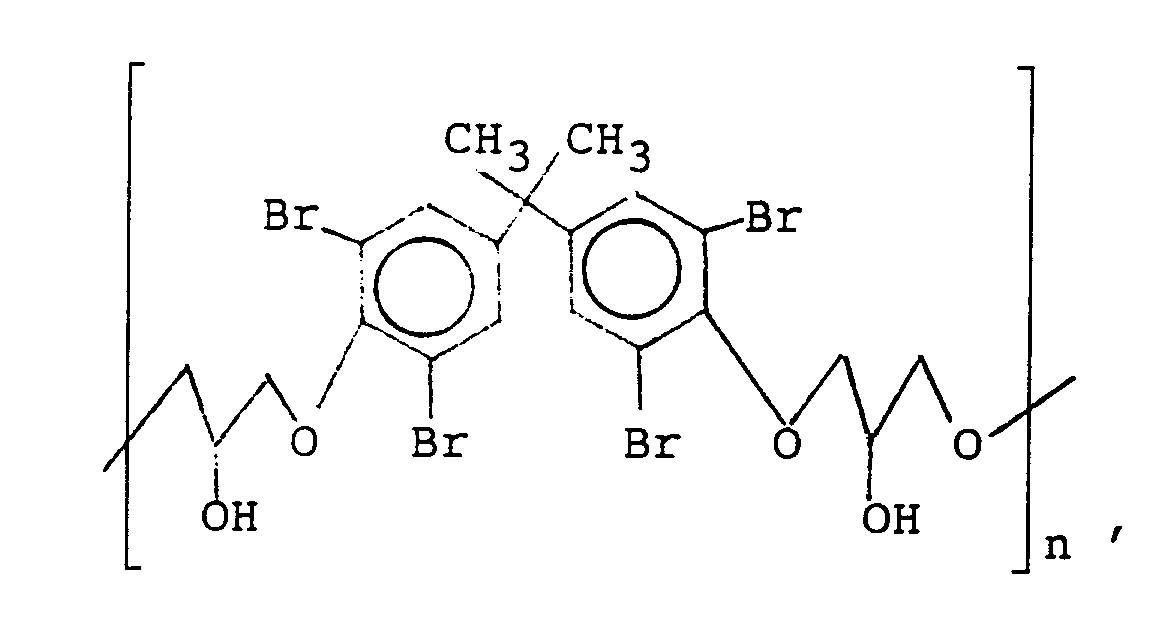
n étant suffisant pour que le poids moléculaire du résidu oligomère ou polymère soit d'environ 700 à 40 000.
n étant suffisant pour que le poids moléculaire du résidu oligomère ou polymère soit d'environ 700 à 40 000.
12. La membrane de la revendication 10 dans laquelle le poids moléculaire est d'environ
700 à 10 000.
13. La membrane de la revendication 11 ou 12 dans laquelle le pourcentage pondéral basé
sur le polyimide aromatique est d'environ 5 à 30 %.
14. La membrane de l'une quelconque des revendications 8 à 13 dans laquelle le polyimide
est essentiellement constitué de motifs répétitifs de formule

dans laquelle R est choisi parmi

où RI est

ou des groupes alkylènes comptant 1 à 5 atomes de carbone, où -RII- est

ou des groupes alkylènes comptant 1 à 5 atomes de carbone ; Ar est
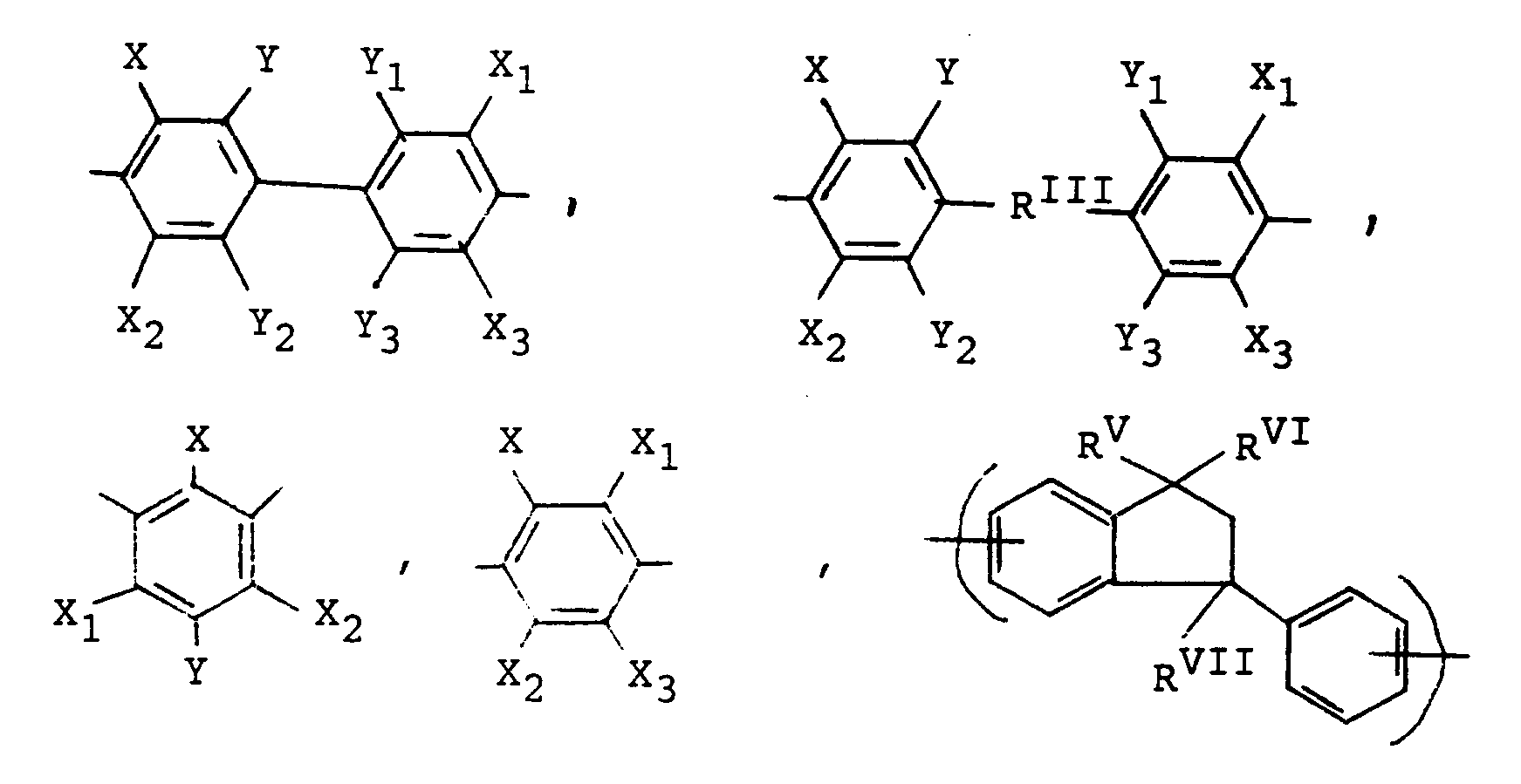
ou leurs mélanges, où -RIII- est
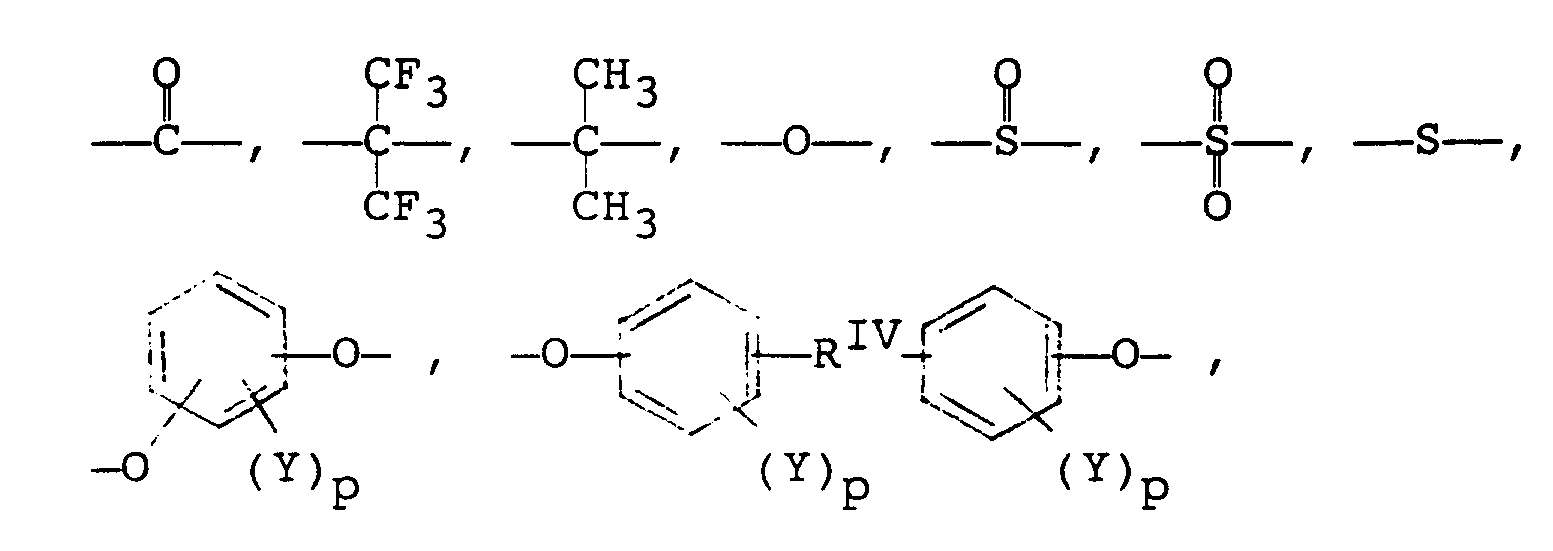
ou des groupes alkylènes comptant 1 à 5 atomes de carbone, où -RIV- est

ou des groupes alkylènes comptant 1 à 5 atomes de carbone, -X-, -X₁-, -X₂- et -X₃- sont indépendamment les uns des autres des groupes alkyles comptant 1 à 5 atomes de carbone, des groupes alcoxy comptant 1 à 5 atomes de carbone ou des groupes phényle ou phénoxy, -Y-, -Y₁-, -Y₂-et -Y₃- sont indépendamment les uns des autres des groupes -H, -X-, -X₁-, -X₂- ou -X₃- ou des atomes d'halogène, et où RV, RVI et RVII sont indépendamment les uns des autres un atome d'hydrogène ou un groupe alkyle inférieur comptant 1 à 6 atomes de carbone ; -Ar'- est

ou leurs mélanges où -RII- RV, RVI et RVII répondent aux mêmes définitions que précédemment, m et n sont des fractions de 0 à 1,0, où

et p est 0 à 3.
dans laquelle R est choisi parmi
où RI est
ou des groupes alkylènes comptant 1 à 5 atomes de carbone, où -RII- est
ou des groupes alkylènes comptant 1 à 5 atomes de carbone ; Ar est
ou leurs mélanges, où -RIII- est
ou des groupes alkylènes comptant 1 à 5 atomes de carbone, où -RIV- est
ou des groupes alkylènes comptant 1 à 5 atomes de carbone, -X-, -X₁-, -X₂- et -X₃- sont indépendamment les uns des autres des groupes alkyles comptant 1 à 5 atomes de carbone, des groupes alcoxy comptant 1 à 5 atomes de carbone ou des groupes phényle ou phénoxy, -Y-, -Y₁-, -Y₂-et -Y₃- sont indépendamment les uns des autres des groupes -H, -X-, -X₁-, -X₂- ou -X₃- ou des atomes d'halogène, et où RV, RVI et RVII sont indépendamment les uns des autres un atome d'hydrogène ou un groupe alkyle inférieur comptant 1 à 6 atomes de carbone ; -Ar'- est
ou leurs mélanges où -RII- RV, RVI et RVII répondent aux mêmes définitions que précédemment, m et n sont des fractions de 0 à 1,0, où
et p est 0 à 3.
